
Summer Garden - one of the most beautiful and famous gardens (along with Mikhailovsky Garden and the Field of Mars) in the central part of St. Petersburg.
The Summer Garden is the oldest park and the pearl of St. Petersburg, it is a park ensemble and a monument of landscape art of the first third of the 18th century.
The garden was founded in 1704 by the decree of Peter I as a private garden for the Summer Palace, on the site of the former Swedish residence (manor) of Captain Erich Berndt von Konau (Konau), consisting of a small house with a farm yard and garden.
The layout of the garden was formed by the 1710s. Russian and foreign architects and gardeners worked on the project: I. Matveev, D. Trezini, J.-B. Leblon, A. Schlueter, M. Zemtsov, F.-B.Rastrelli, gardeners Ya.Roozen, I. Surmin, K. Schroeder, I. Yakovlev, P. Lukyanov and others.
The core of the garden was the Summer Palace of Peter I, built in 1711-1712 in the style of Peter's Baroque by the architect Domenico Trezzini.
Within a few years of its existence, the Summer Garden became the center of political and official life, court ceremonies and celebrations.
During the history of the Summer Garden, new buildings, monuments and fountains appeared in it.
In the Summer Garden there were entertainment and household buildings, most of which have not survived to our time (galleries, a grotto, greenhouses, a service building of Human chambers, a chapel in the Nevsky fence of the garden, a palace for Catherine I, a new Summer Palace for the Empress Anna Ioannovna); as well as parterres, a pond, fountains and sculptures that decorated the garden.
Since the 19th century, the Summer Garden has become a favorite place for walks and recreation for citizens and guests of the city.
The name "Summer" Garden was given due to the fact that the Summer Palace with a garden was the summer residence in which the royal family lived from May to October.
In 1934, the Summer Garden received the status of a museum, which it is still today-it is part of State Russian Museum.
Later, the garden was restored and today it can be visited by anyone. Admission is free (free of charge).
In the Summer Garden there are: the Summer Palace of Peter I (now a museum), other buildings (pavilions), alleys and paths for walking, cafes, places for recreation, a pond, a parterre, bosquets, borsos, fountains, sculptures, monuments and an exposition of the history of the Summer Garden.
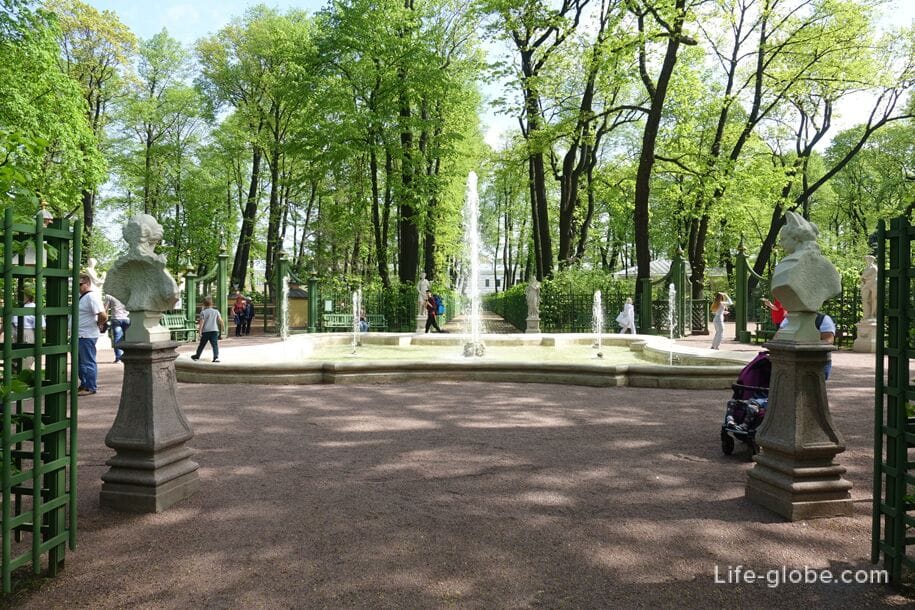

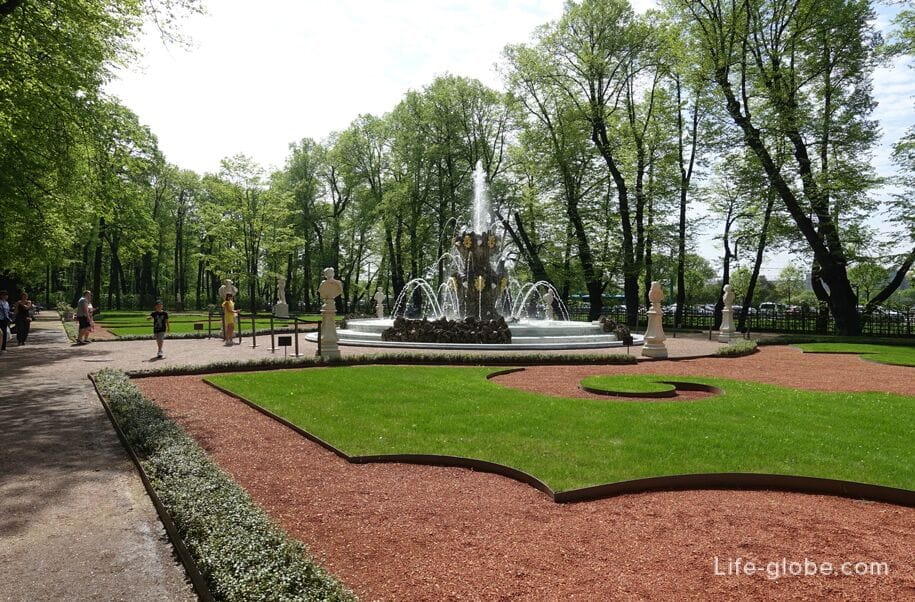
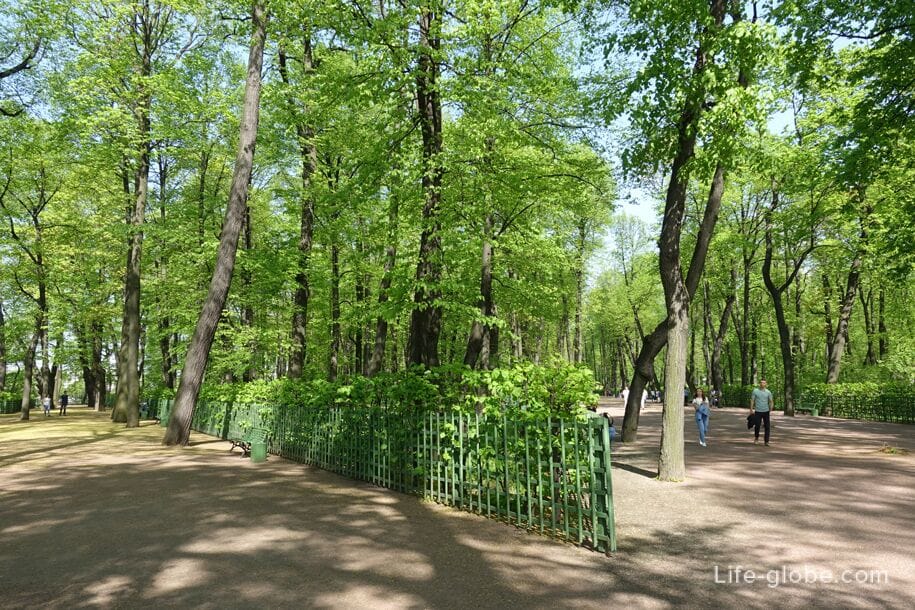

The Summer Garden occupies a separate island of the same name, washed by the rivers Neva, Fontanka, Moika and Lebyazhya Kanavka.
Photo of the Summer Garden (right) and the Swan Canal
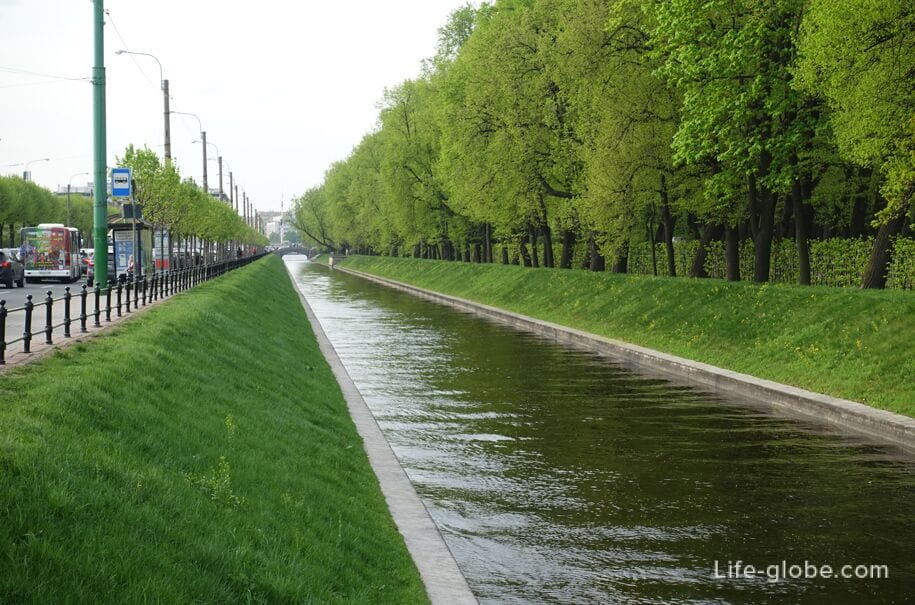
Photo of the Summer Garden (right) and the Fontanka River with Laundry Bridge
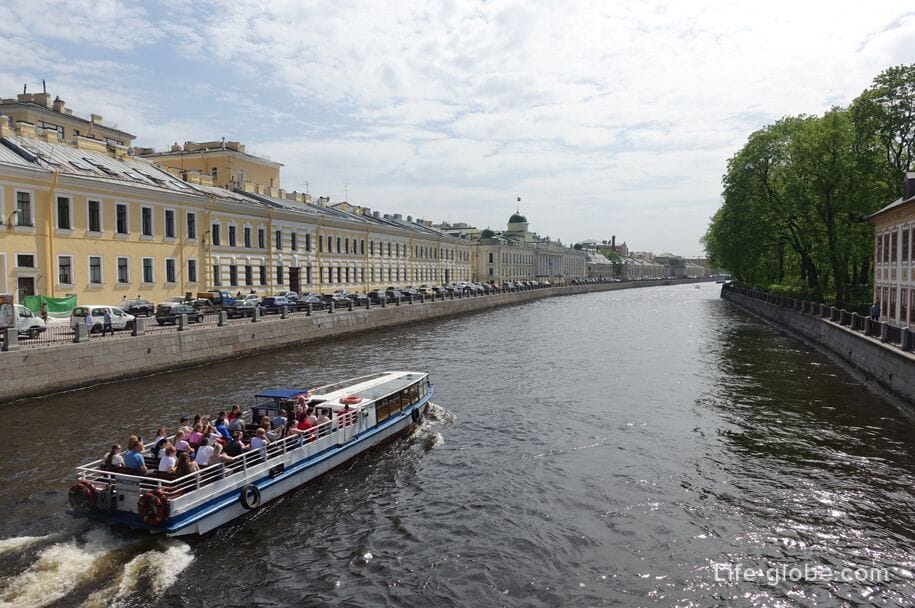

The entrance to the Summer Garden is possible through the gate from the Moika River embankment and from the Palace embankment on the side of the Neva River.
On the side of the Moika River under Emperor Nicholas I, the garden was surrounded by a cast-iron fence designed by architects P. Bazin and L. Charlemagne.
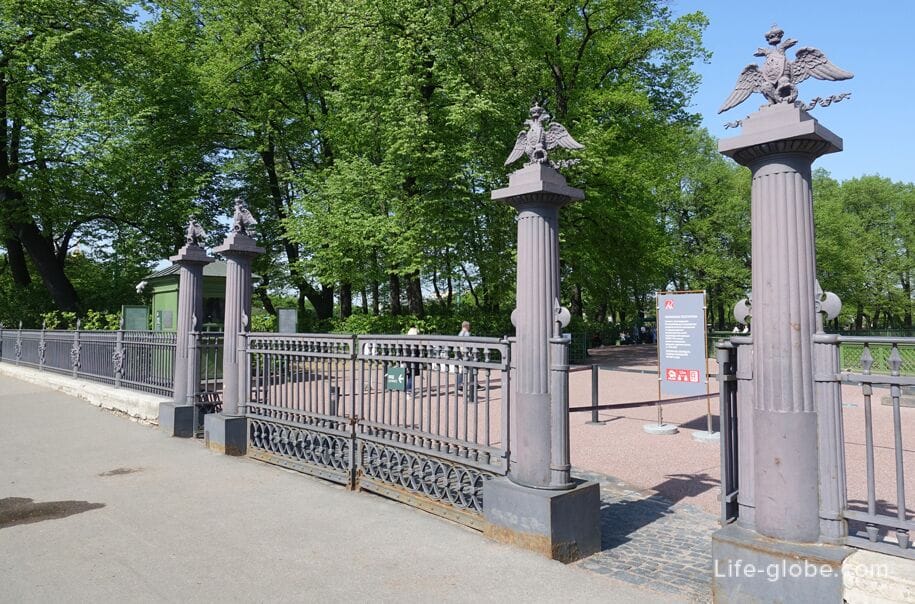
The garden received a fence on the side of the Neva River under Catherine II, made by the architect Yu. Felten. The base of the fence, the columns and the vases crowning them were carved from "wild stone" - so in the 18th century the red granite of the Vyborg deposits was called. The links of the fence and the gate were forged from iron in Tula.
The fence has bronze gilded ornaments that enliven the strict appearance of the Summer Garden lattice.
The links of the fence are reinforced on 36 posts. The total length of the structure is 232 meters.
Originally, there were three gates in the fence. The central gate had a different ending from the side gates. In 1866, the fence became a silent witness to a historical event - an attempt on the life of Emperor Alexander II. In memory of the deliverance of the sovereign from mortal danger, a chapel was built on the site of the central gate, and the side gate was moved and placed on the sides of the chapel. In 1930, the chapel was dismantled.

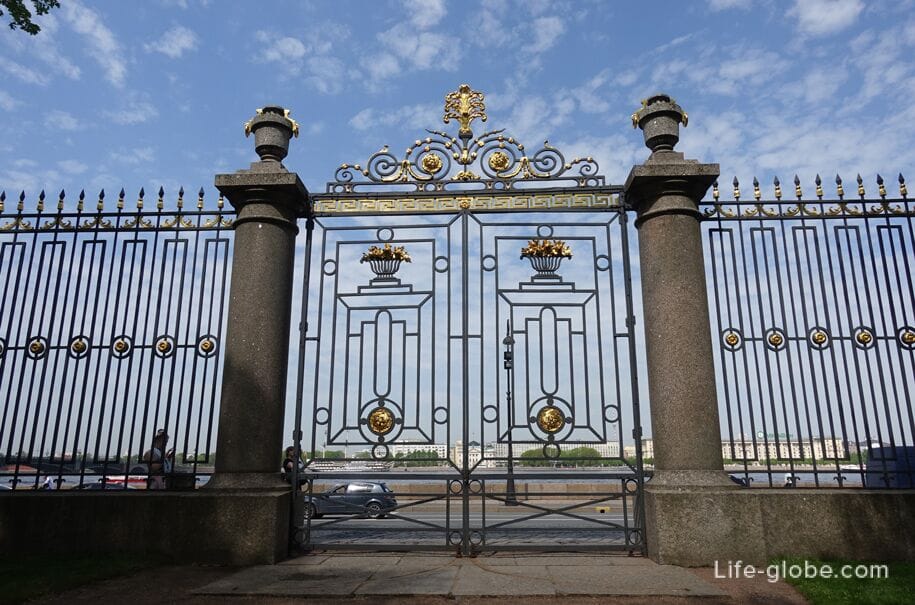
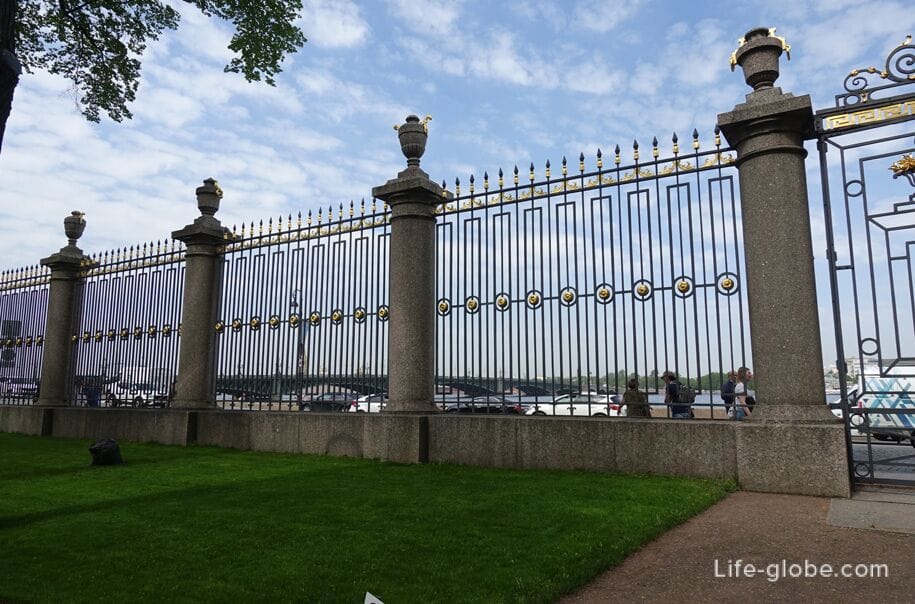
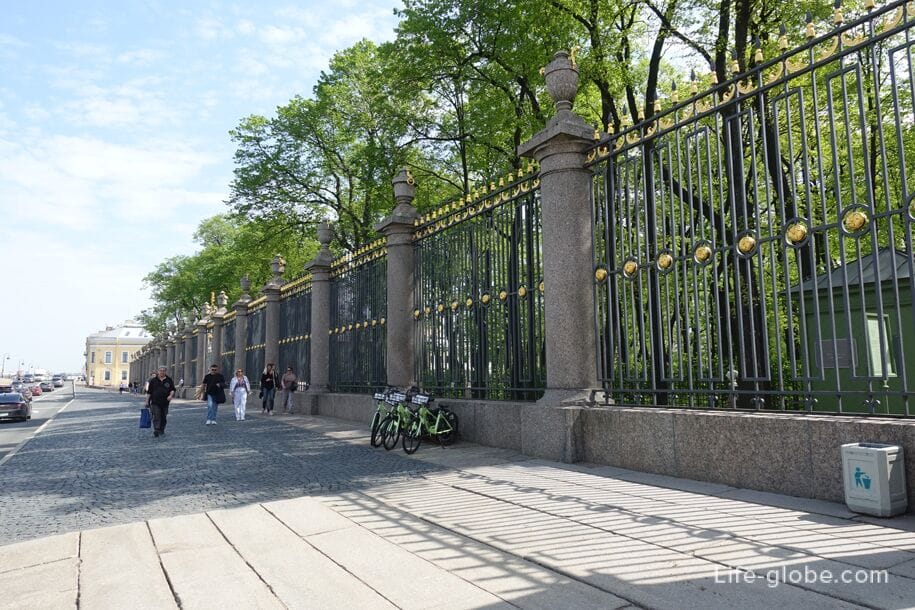
A special place in the Summer Garden is occupied by the Summer Palace of Peter I, which was a summer residence and has been preserved to this day almost in its original form.
Today, the palace is a unique historical and architectural, memorial and artistic monument, as well as a museum with a permanent exhibition in the restored halls and rooms of the palace, where you can see some furniture, objects and costumes of past centuries.
Entrance to the museum is paid. Read more about the Summer Palace of Peter the Great…
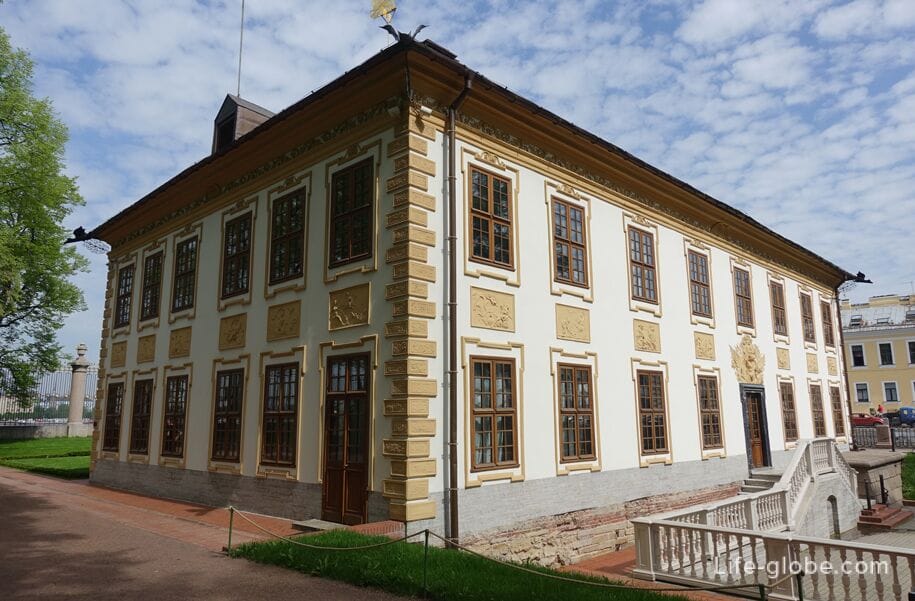
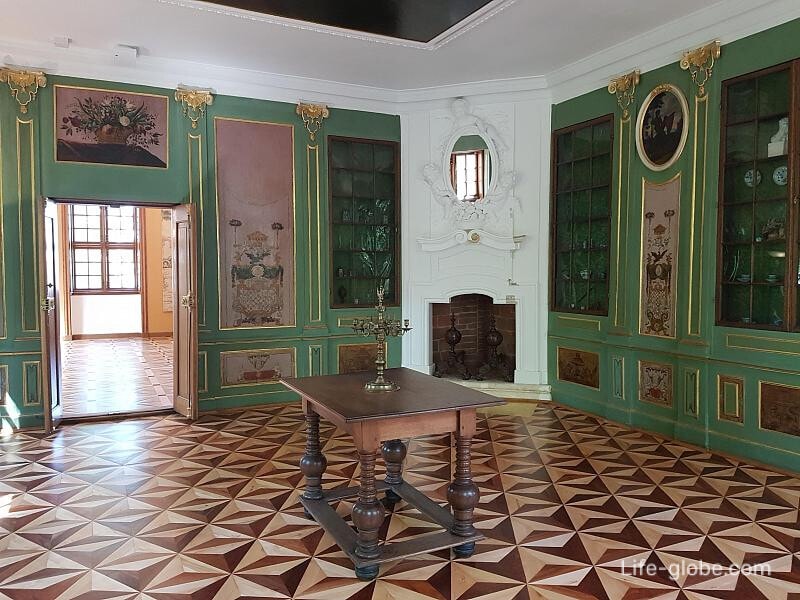
Adjacent to the palace was a section of the granite embankment and the Peter the Great Harbor, the name given to the bucket-shaped harbor built by master Ivan Matveev and used for small boats to approach the garden.
Havanets lasted until 1780. Currently, the retaining walls of the Harbor with wrought-iron mooring rings are partially cleared and museumified.
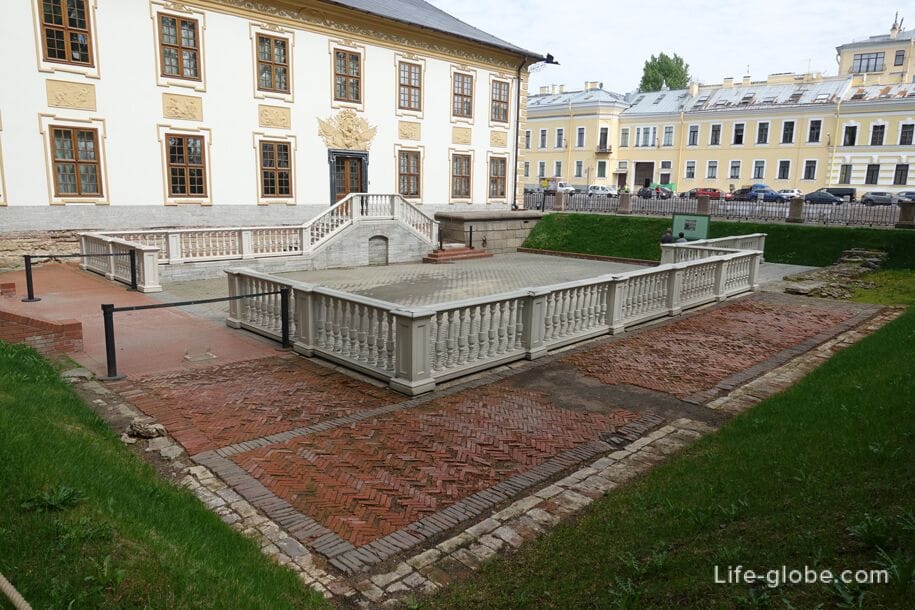
Elfdalen Porphyry Vase
At the southern gate of the garden (on the side of the Moika River) on a high pedestal is a parfyre vase, installed in 1839.
The vase was a gift to Emperor Nicholas I from the Swedish King Karl Johann XIV. The vase was made in the city of Elfdalen (Sweden) and is called Elfdalen.
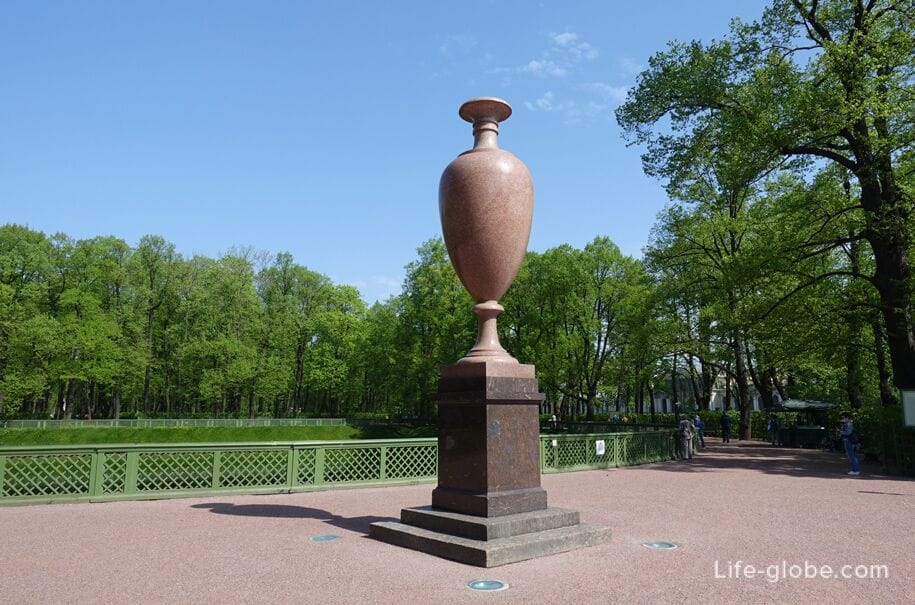
Karpiev pond
Behind the vase is the large Karpiev Pond, created in 1714-1716 as part of a specially designed chain of cascade ponds, which also included three other now-defunct ponds: the Flower Pond, the Trout Pond, and the Mill Pond. The reservoirs were created both for reclamation purposes, for drainage and improvement of the park area, and for fish breeding.

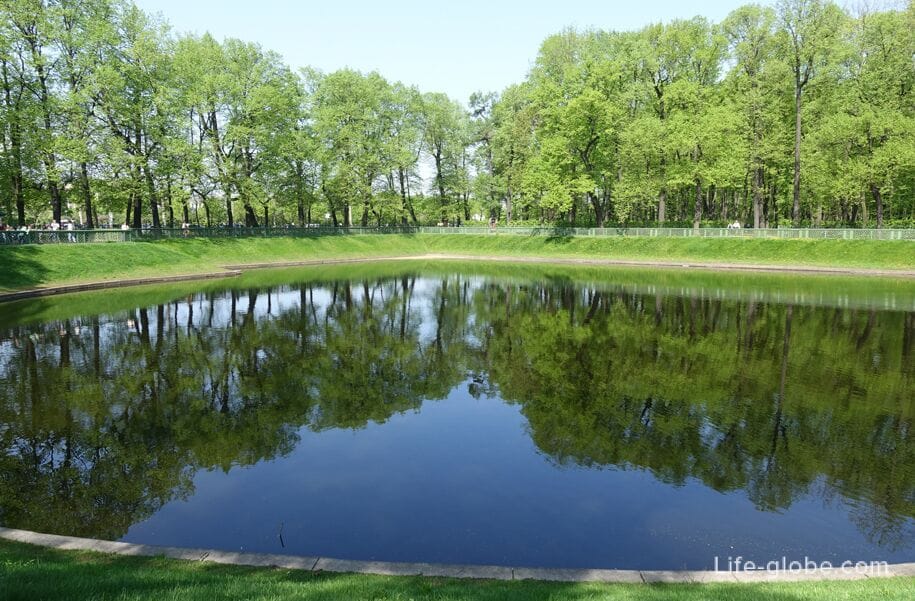
Alleys
From the pond to the interior of the Summer Garden are alleys (Main, Economic, School and the Alley of Old Linden Trees or Swan Alley), which intersect several perpendicular alleys.
Trees and ornamental shrubs grow along the alleys, bosquets are equipped, places for recreation are installed, there are sculptures and a former pier on the side of the Swan Groove. More about Swan's Groove...
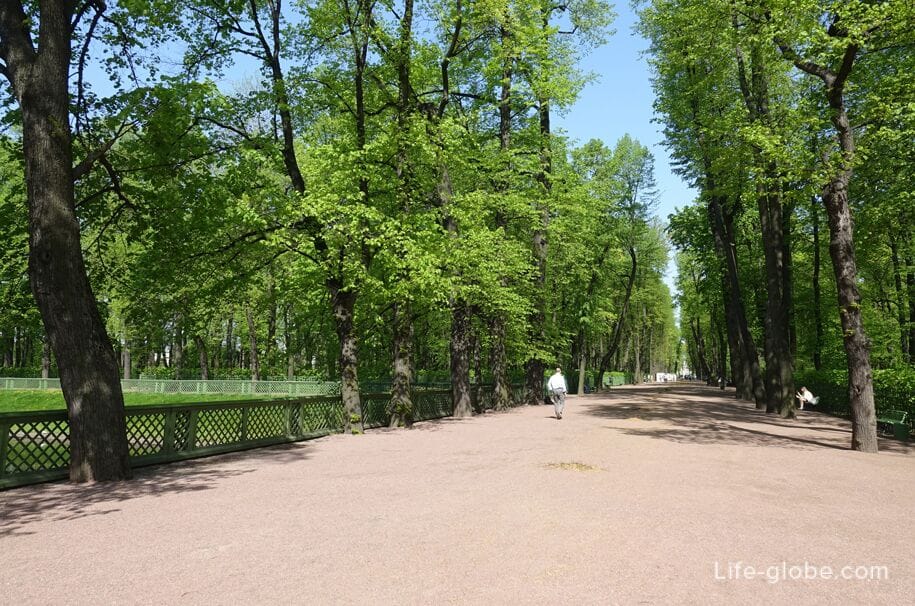
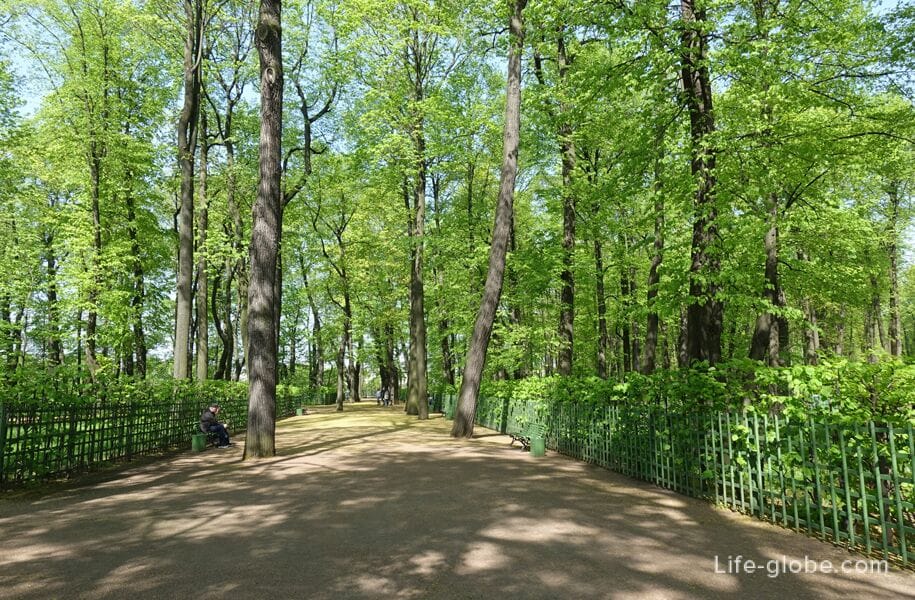

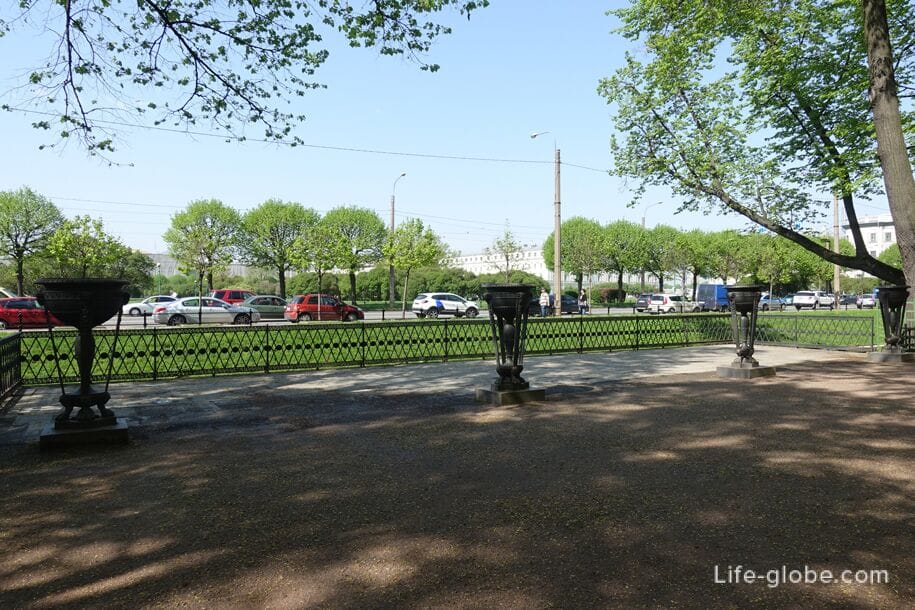
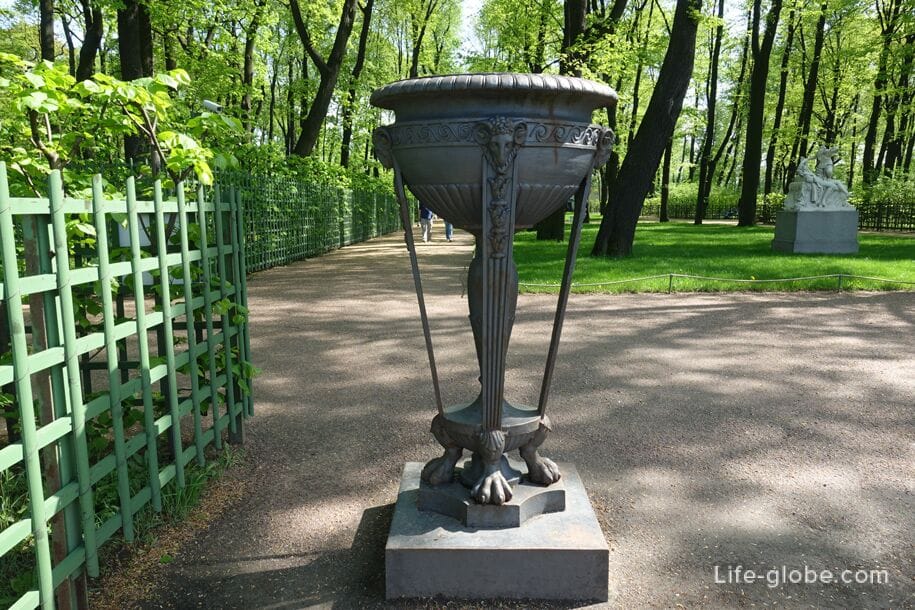

Sculpture Cupid and Psyche, Bernini school, Italy, late 17th century.
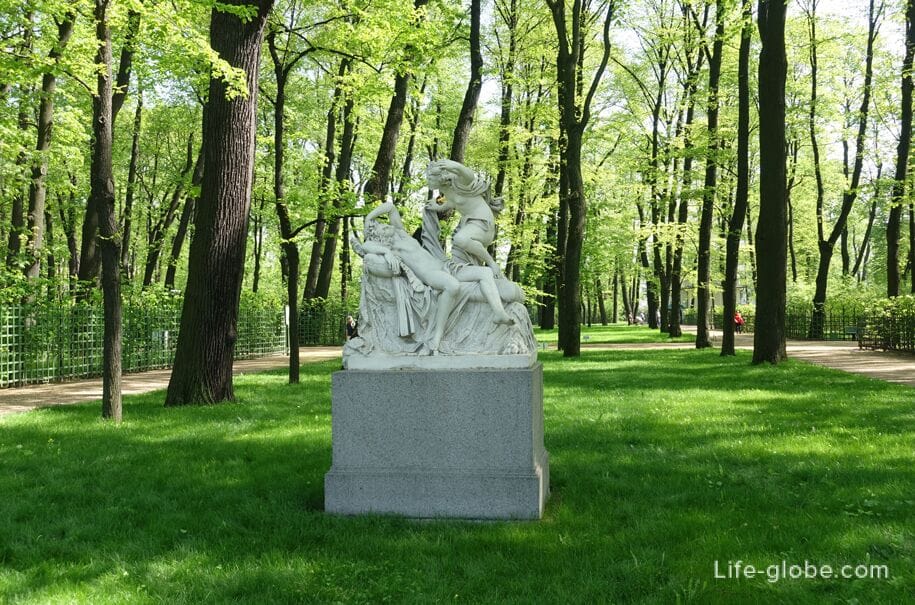

Greenhouse with garden and adjacent buildings
In the central part of the garden, on the Fontanka side, there are: the pavilion "Small Greenhouse" with a Red garden (Orangery Garden), an economic building and a "Coffee House".
For the first time, the building of the "Small Greenhouse" was recorded on the dimensional plan of the garden around 1736. In the greenhouses of the Summer Garden, watermelons, melons, pineapples, pomegranates, grapes were grown, laurel, "coffee and other overseas trees"were kept.
The building of the Small Greenhouse was recreated in 2010-2011. Currently, there is a cafe in the building of the greenhouse; it is also used for the maintenance of the garden's subtropical tub plants in winter.
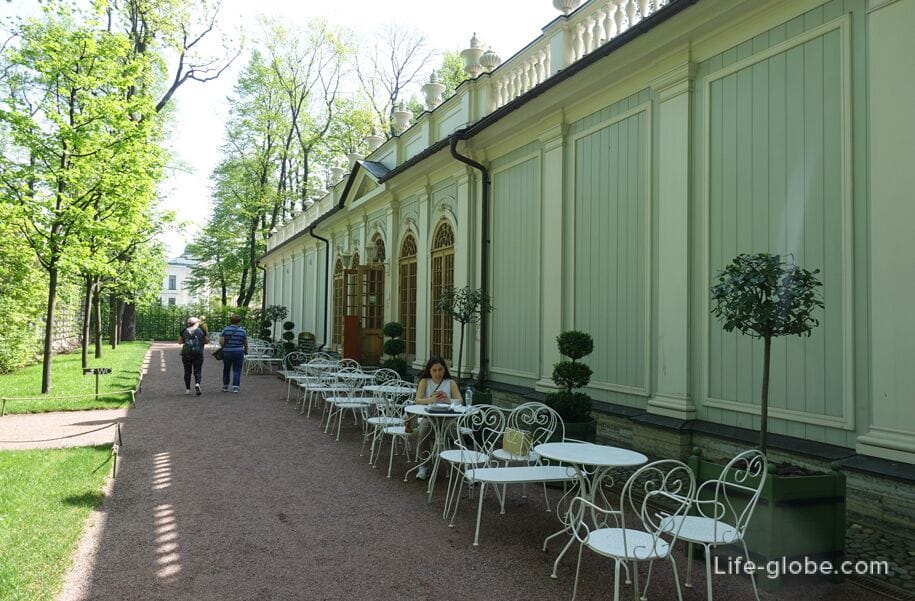
Behind the pavilion "Small Greenhouse" there was once a plot called "Red Garden".» or the "Greenhouse Garden", which contained a flower porter with a fountain, greenhouses and outbuildings. There were also fruit trees: apple trees, pears, cherries; there was a "Pharmacy" vegetable garden, on the beds of which vegetables were grown, "pharmacy", "cook" and "curious" herbs, as well as fragrant and spicy plants.
This vegetable garden not only supplied fresh herbs, vegetables and fruits to the royal table, but its assortment also served an educational purpose - in Peter's time, potatoes, artichokes, lettuce and asparagus, which were then outlandish, were grown here.
Today, the" Red Garden " presents vegetable, medicinal and ornamental plants, which, according to historical information, were grown in the Summer Garden of Peter the Great.
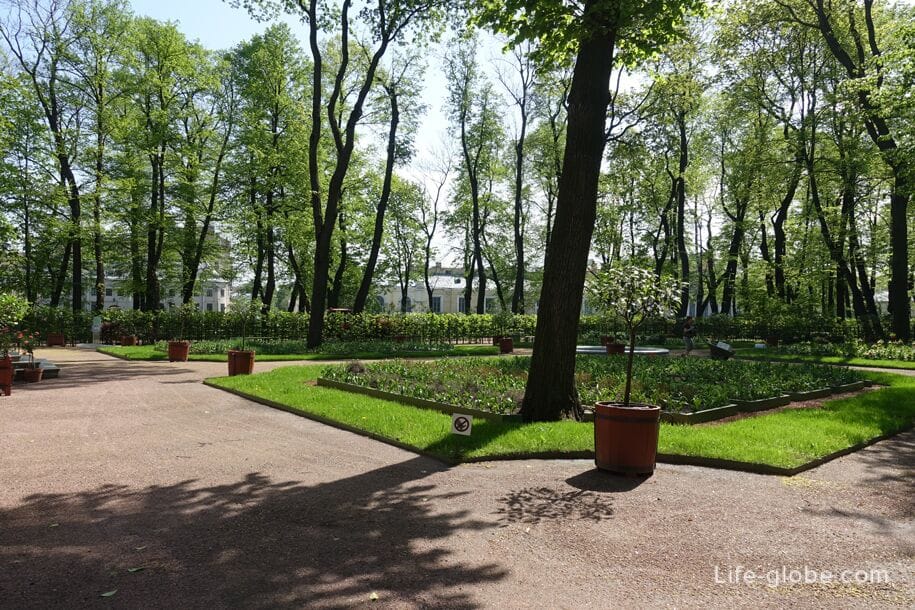
The pavilion "Coffee House" was created in 1826, when the remains of the pavilion "Grotto" were rebuilt by the architect K. Rossi as a coffee shop. Today it is a cafe.
Near the "Coffee House" are: pavilion museumfication of the fountain "Lacoste" and a children's playground.

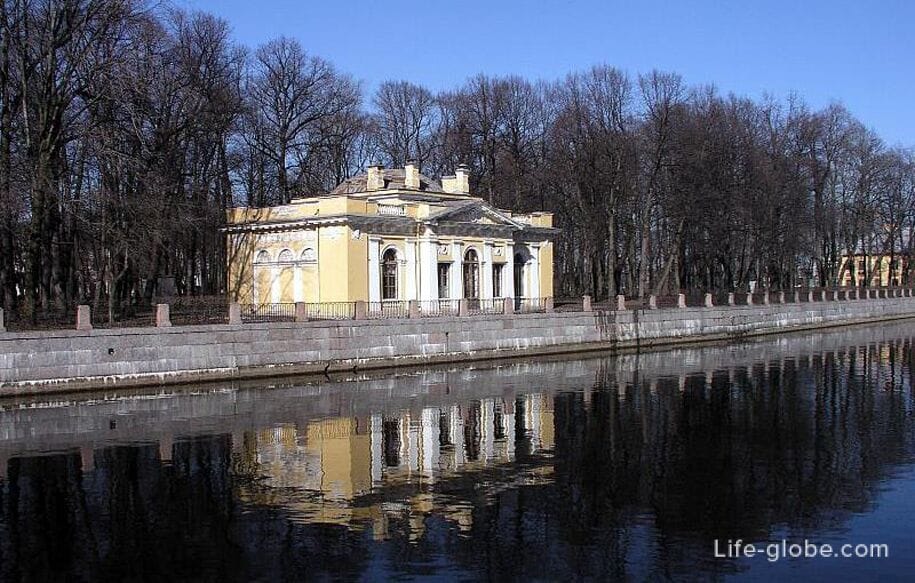
Teahouse
The wooden pavilion "Tea House" was built in 1827 near the "Coffee House" by the architect L. Charlemagne.
The restoration of the pavilion took place in 1981-1983.
Its walls are built of logs and covered with boards, and the facades are executed in the style of Russian classicism.
Today it is a museum-shop and cafe.
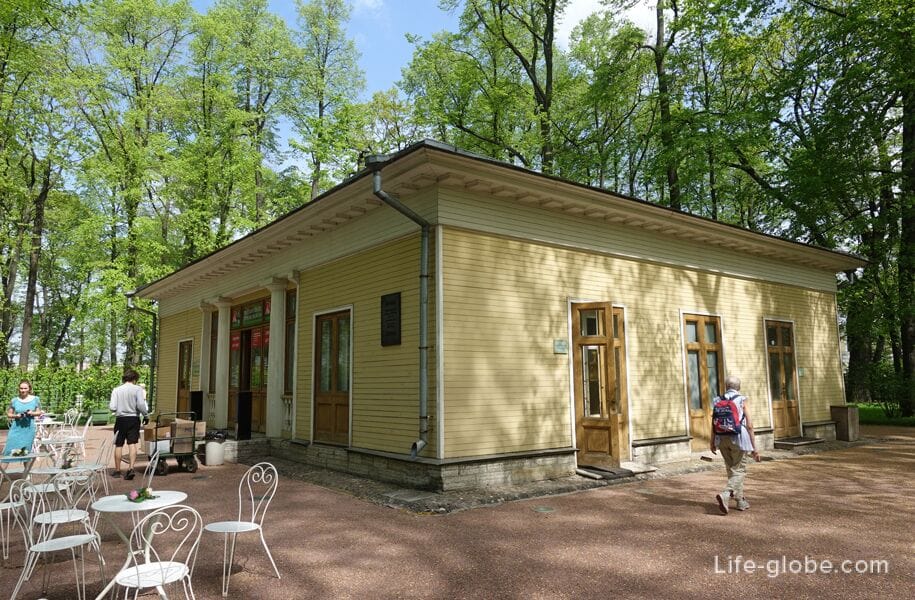
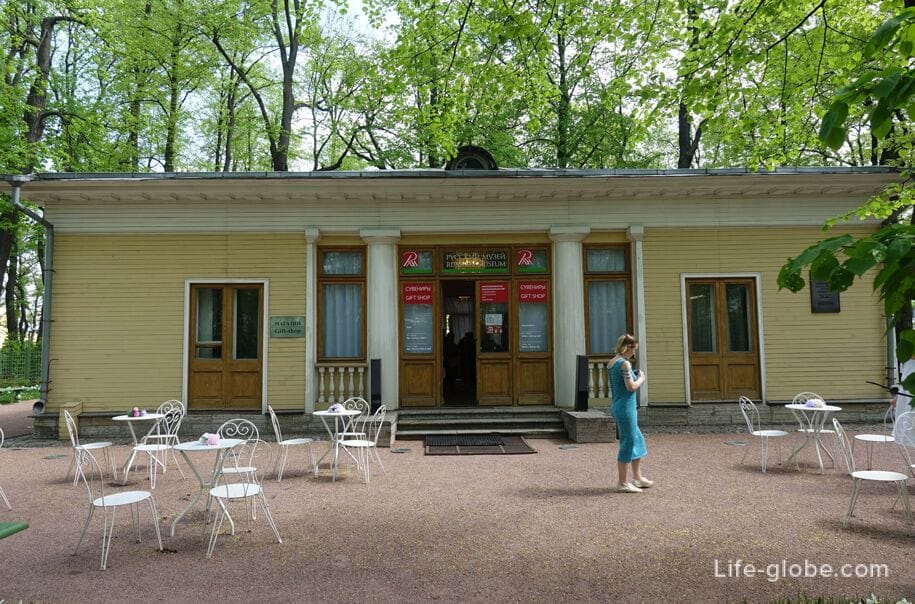
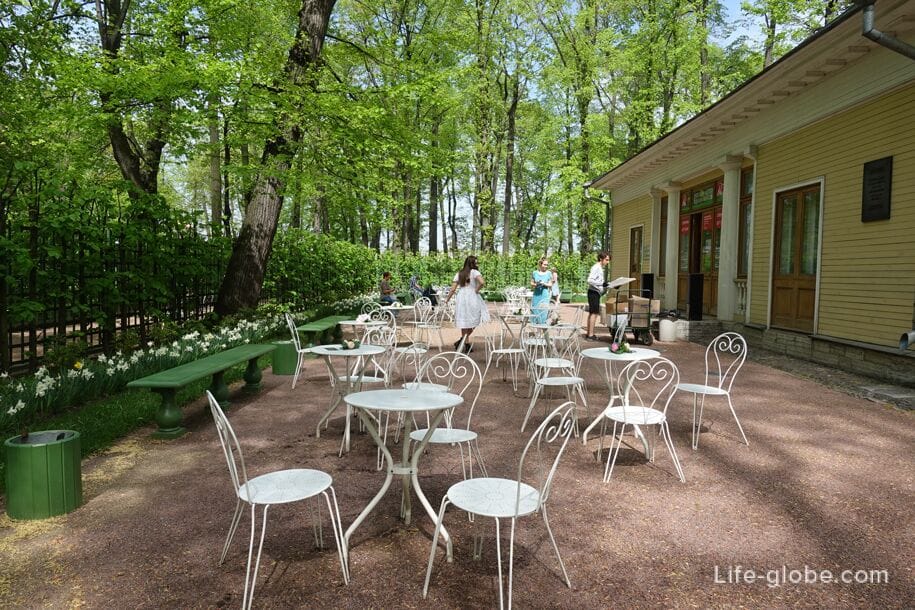
Fountains and sculptures
In the Summer Garden there are sculptures and sculptural busts, the main mass of which is concentrated in the northern part of the garden and depicts ancient gods, Roman emperors, allegories of virtues, elements, seasons and days.
92 marble sculptural works of Peter's time (statues, sculptural groups and busts) have survived to this day. The main part of the collection of sculptures of the Summer Garden is made up of sculptures by Italian masters of the late 17th - early 18th centuries (now these are copies, and the originals, for the sake of preservation, were moved to Mikhailovsky Castle).
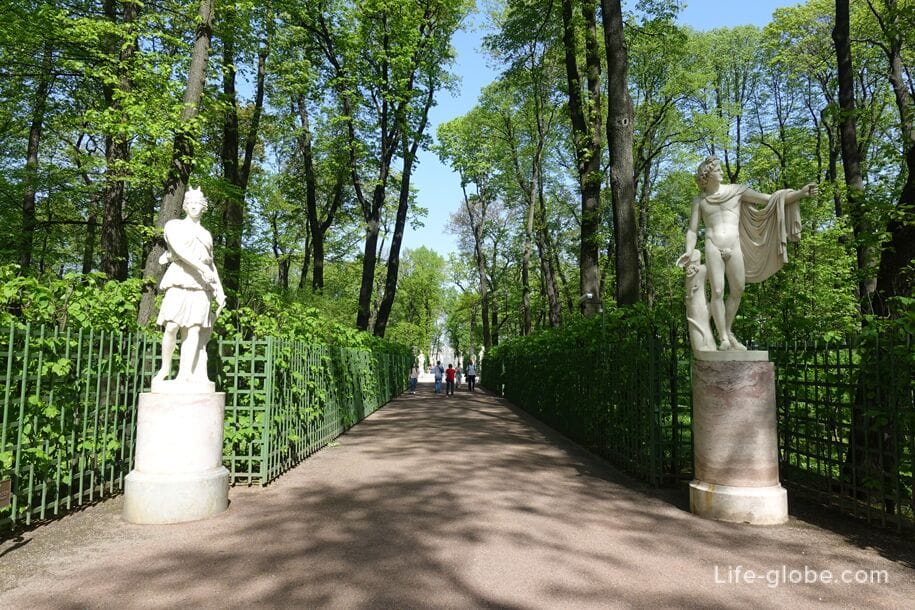

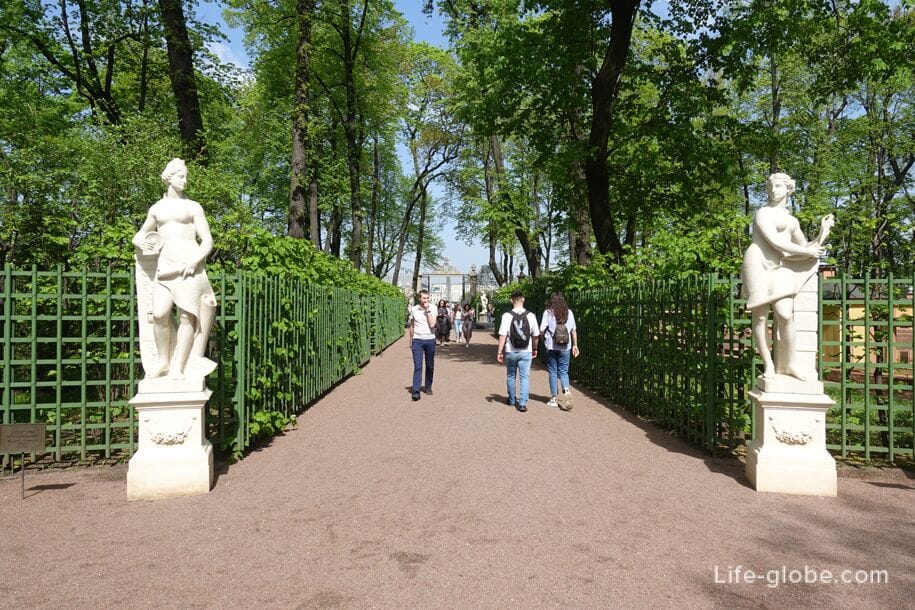

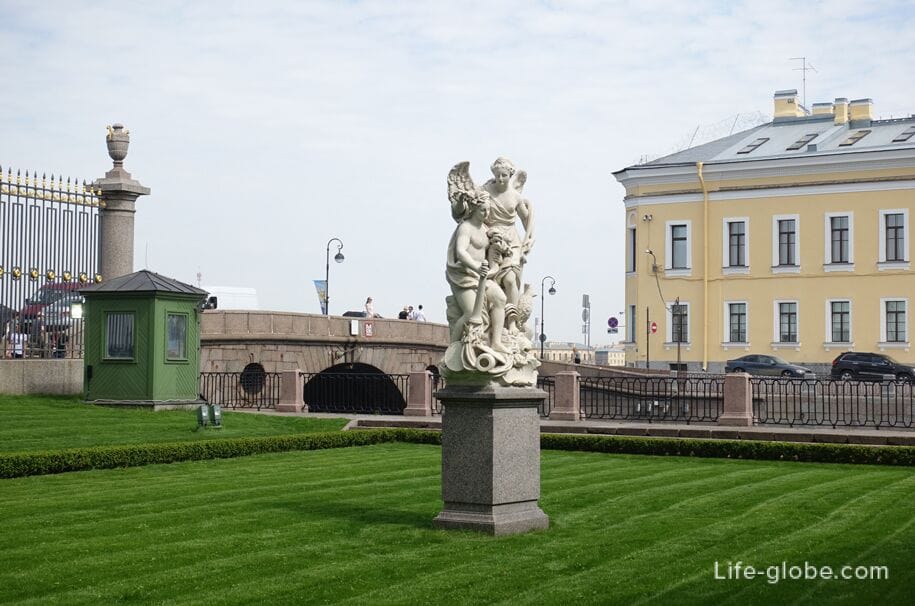
On the Main avenue of the garden there are four fountains lined up in a row, which together represent a picturesque fountain ensemble.
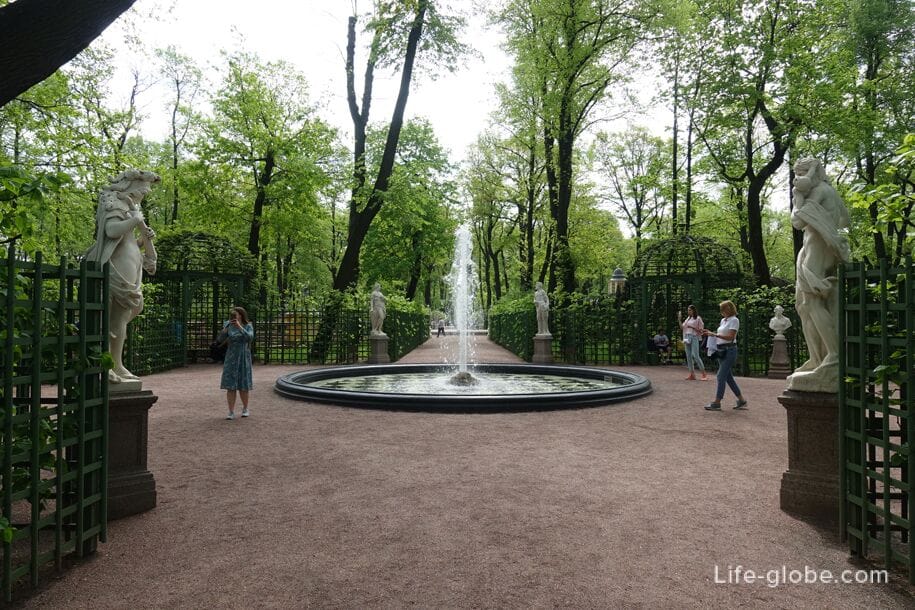
These are fountains such as:
- Pyramid fountain»;
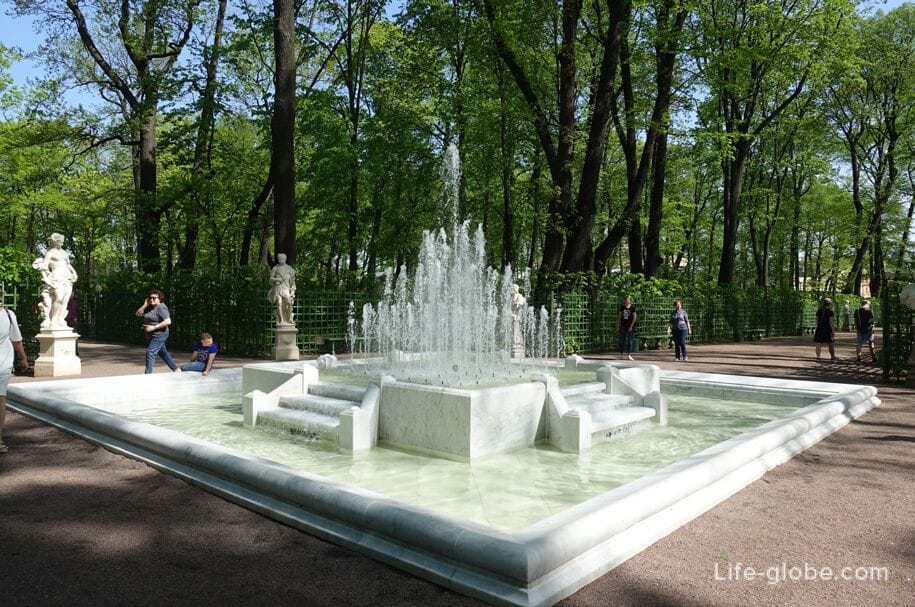
- fountain on the third landing;
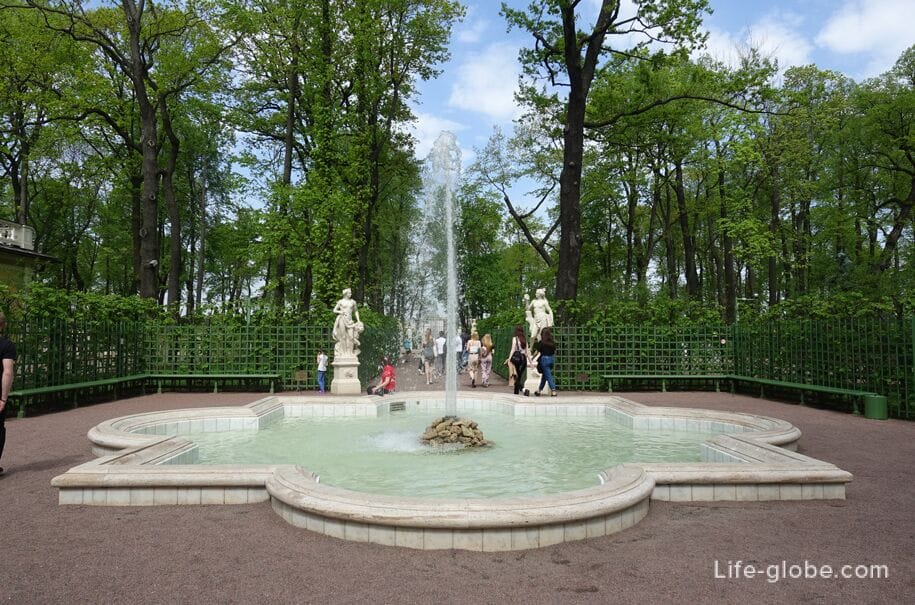
- Coat of Arms fountain;
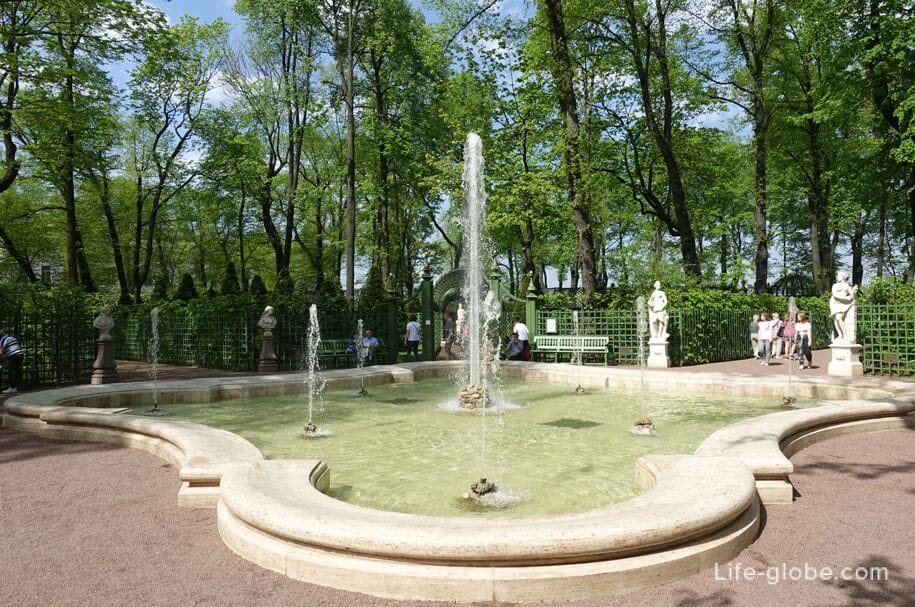
- the fountain on the Tsaritsyn Square.
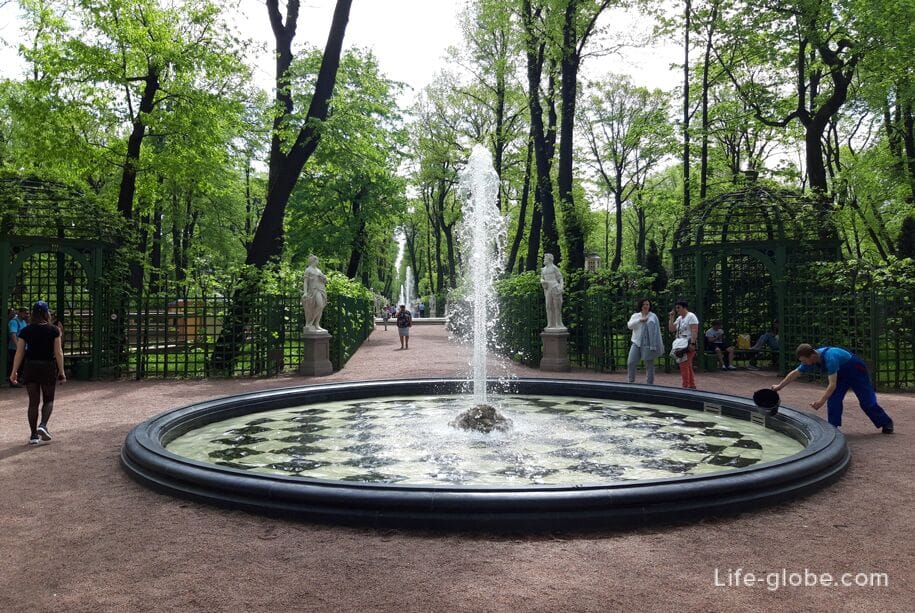
Bosquettes
From the platform with the Coat of Arms Fountain, four bosquets diverge in different directions.
Bosket (from the Italian "boscbetto" - "grove") - a closed section of a garden of regular geometric shape, bounded by a hedge of clipped plants. The interior space of the bosket was used for the placement of garden projects, as well as for the free planting of trees.
Bosket "Krestovoe Gulbishche" was built in the late 1710s and originally had the name "Spruce Grove".
In terms of this bosquet with two diagonal alleys-berseau resembles St. Andrew's cross.
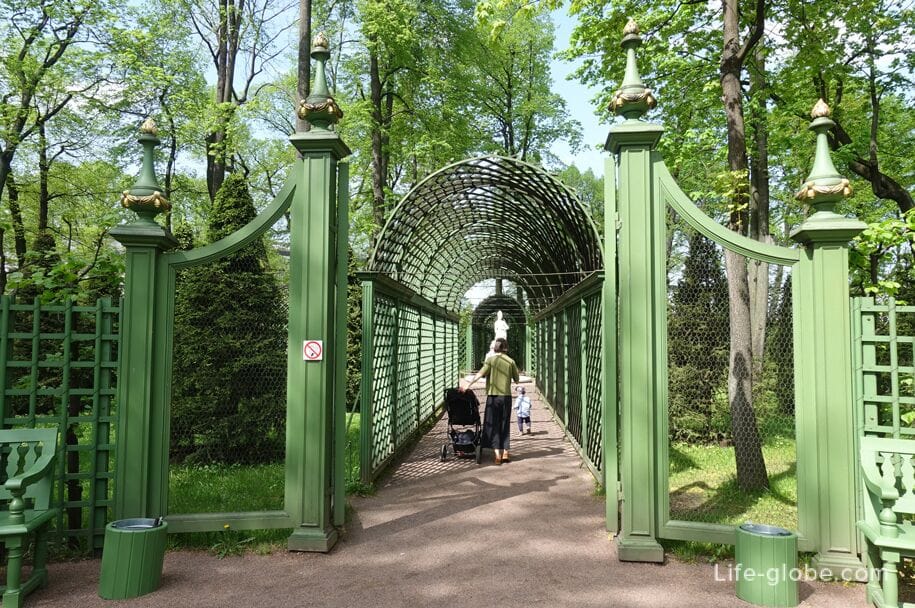
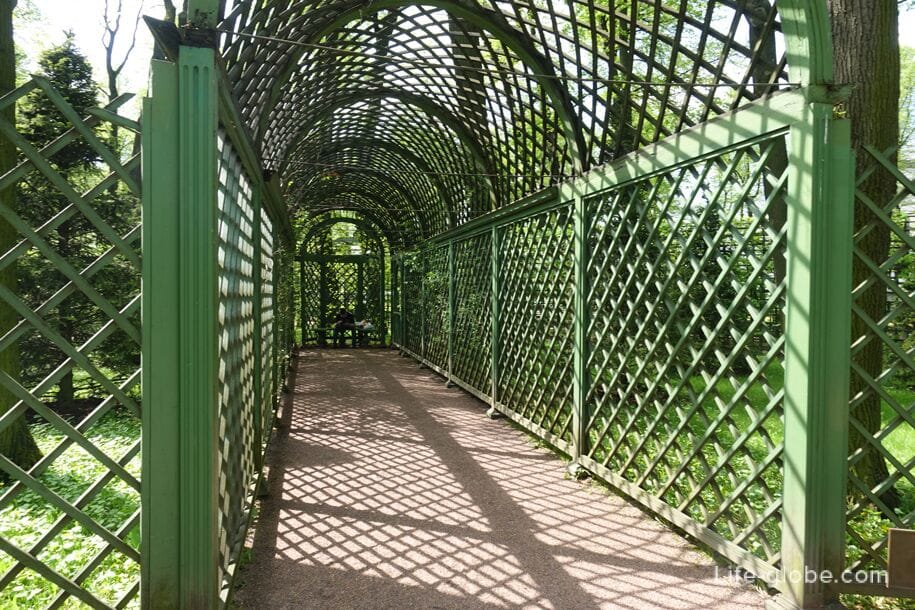
On the site in the center of Bosket is a fountain with a copy of the statue "Nereid" by Antonio Corradini from the collection of sculptures of the Summer Garden. In ancient mythology, Nereids are sea nymphs, the patronesses of sailors.
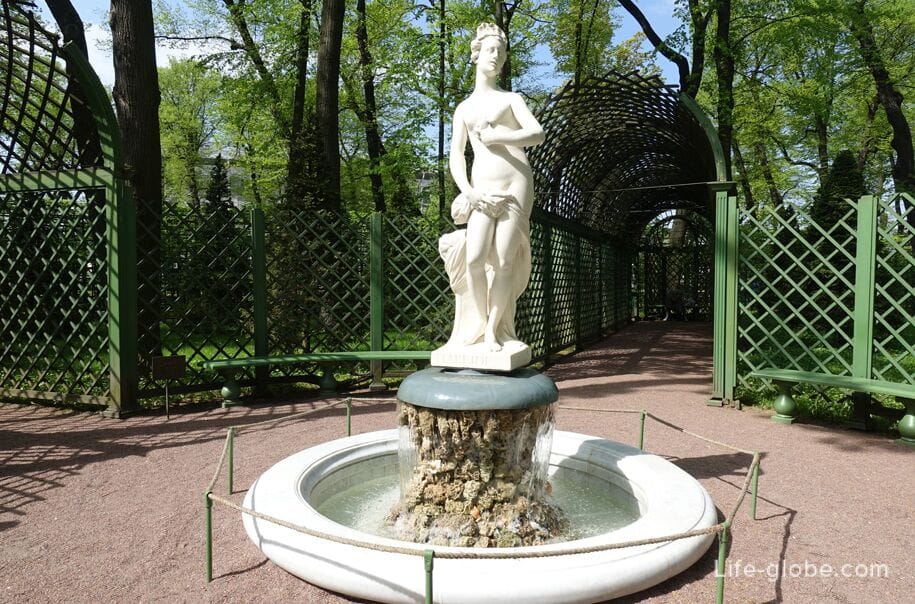
Bosquet "Menagerie pond", the name of which comes from the French "menagerie" - "menagerie". In architecture, the term "menagerie" means a house for keeping birds.
In the center of bosket is an artificial pond in the form of a regular oval, which was arranged in 1719-1720. In the center of the pond there was (and still is) an island with a gazebo, about which it is said that Peter I liked to spend time here in thought or to be alone with a guest.
Along the perimeter of the pond there was a trellis fence and 8 "houses" for ducks and geese of rare breeds.
In 1786, the pond was filled in. Bosket was recreated in 2010-2011 at new elevations, but in historical dimensions.
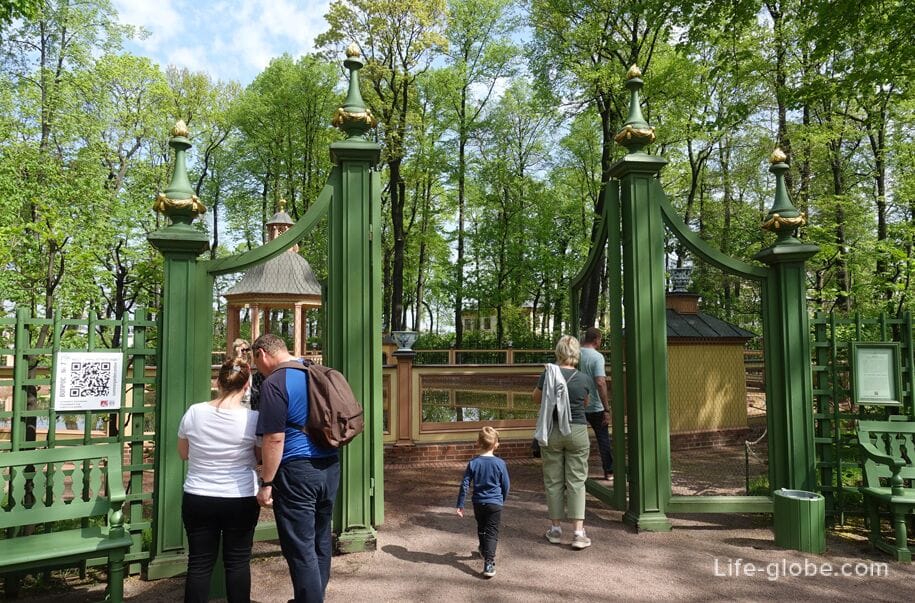
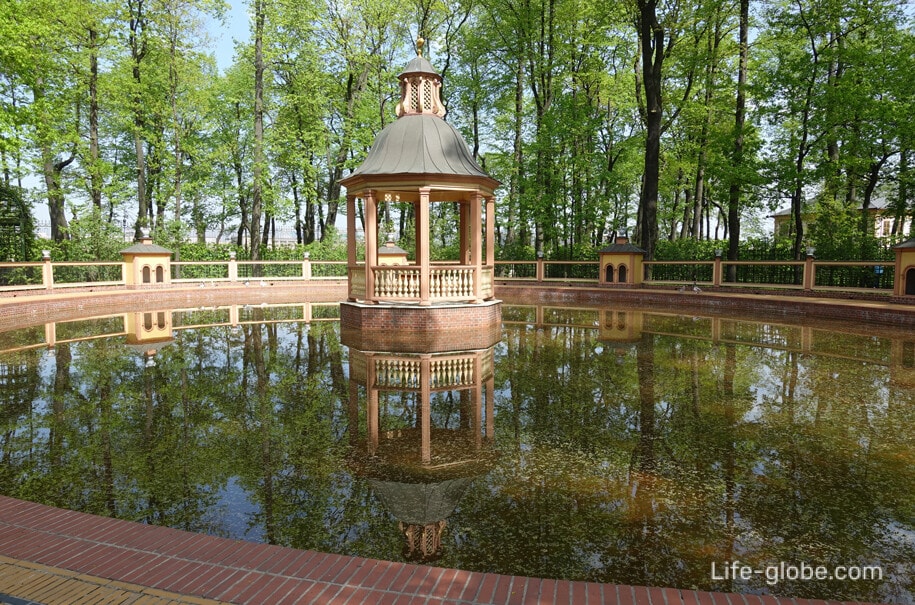
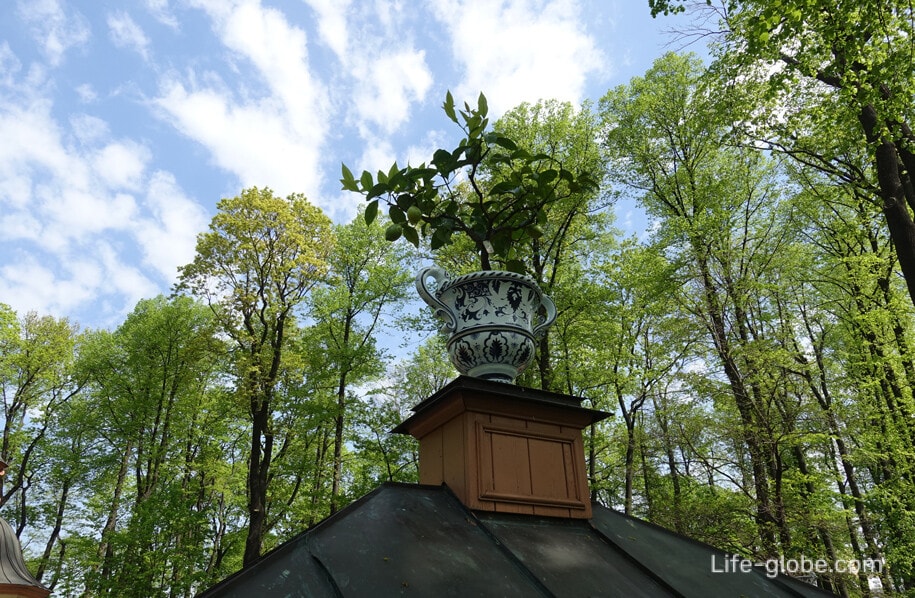
Bosquet "French porter" in which there was a pyramid-shaped Dolphin cascade, richly decorated with lead gilded sculptures and flowerpots, created in 1721 by the French master Nicolo Pinot. Bosket was surrounded by a trellis fence with niches and carved lanterns. The bosquet also contained a marble sculpture of a horse on a pedestal, by Pietro Baratta , a smaller copy of the monument to Marcus Aurelius (without a rider), delivered in 1722 from Venice.
The buildings were badly damaged during the flood of 1777 and were dismantled in the 1780s.
In 1855, a bronze monument to the fabulist I. A. Krylov by the sculptor Peter Klodt was erected on the bosket site. It was the first monument to the writer in Russia. The monument to Krylov can still be seen in Bosket today. More about the monument to Krylov...
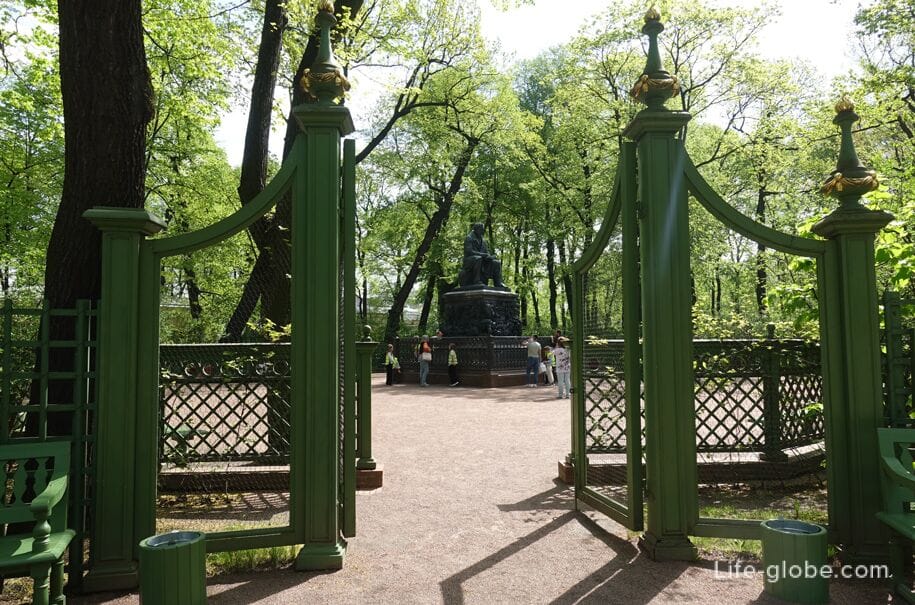
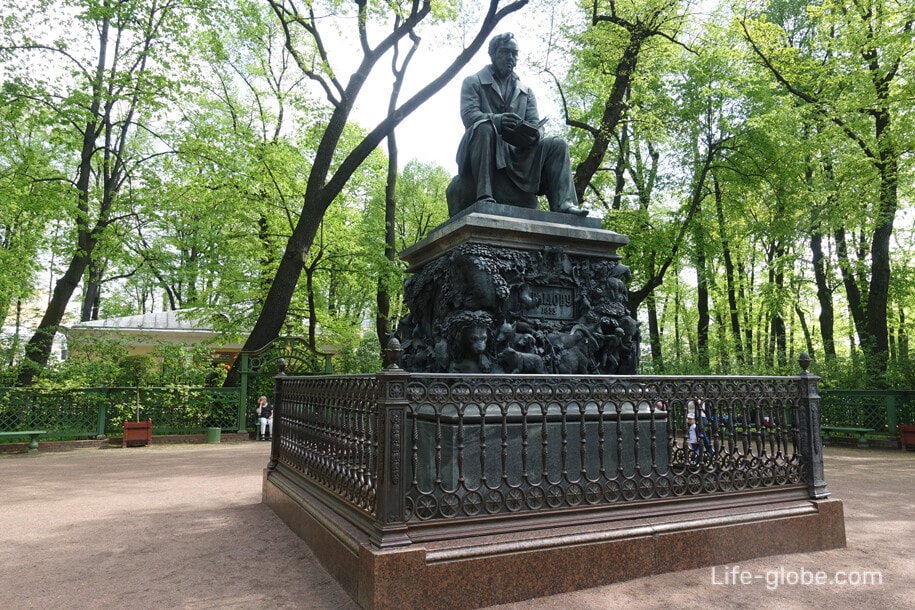
Bosket "Bird Yard" was built in the 1710s. Later, it housed a "bird yard", with aviaries, cages and a pavilion-dovecote. In the aviaries and cages were "overseas" birds and animals, and in the pavilion-dovecote kept pigeons of rare breeds.
Bosquet decorated the fountain.
All of Bosket's structures were dismantled in the 1780s.
Bosket was recreated in 2010-2011. In the center of the bosket there is a small fountain, with cages on the side.
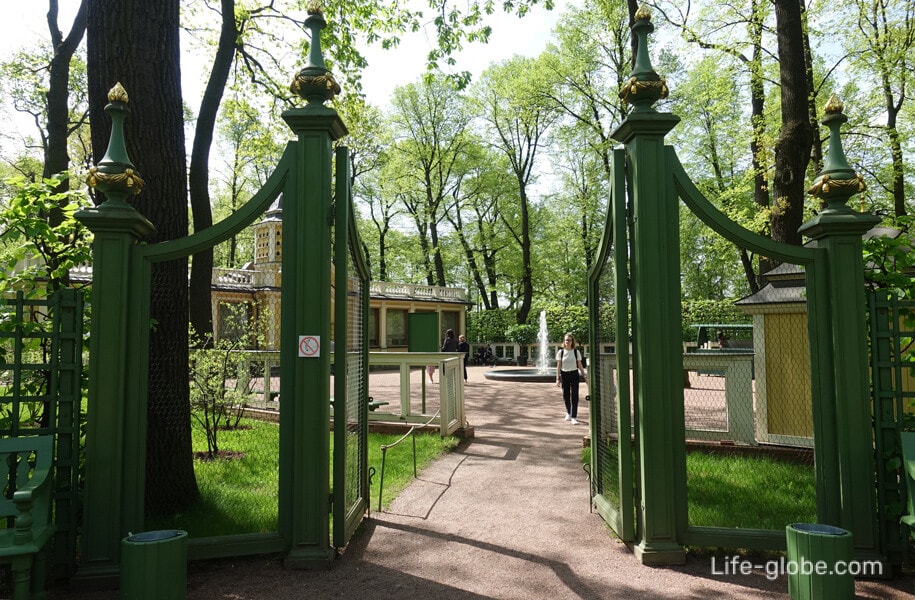

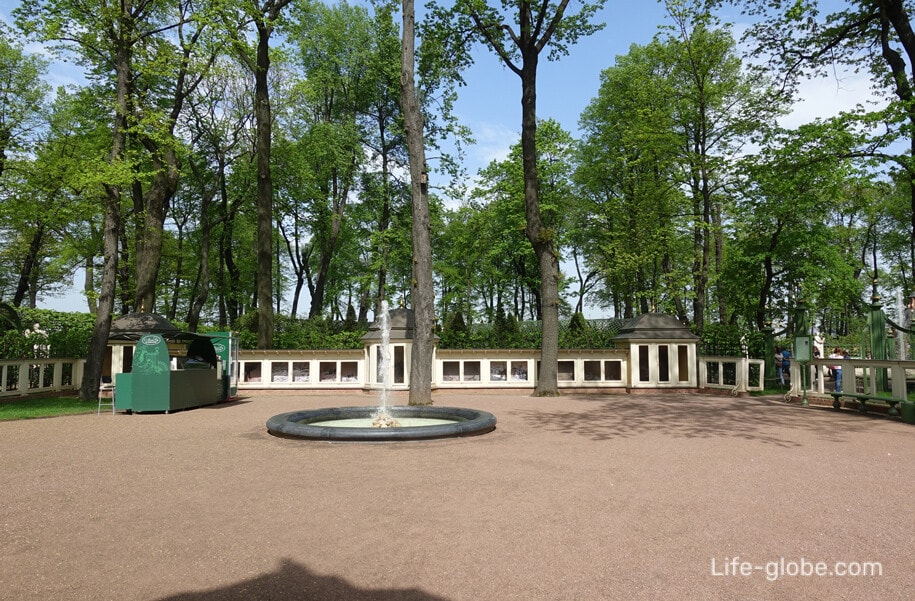
The restored dovecote now houses the exhibition "Museum of the history of the Summer Garden". Admission to the exhibition is free (free of charge).
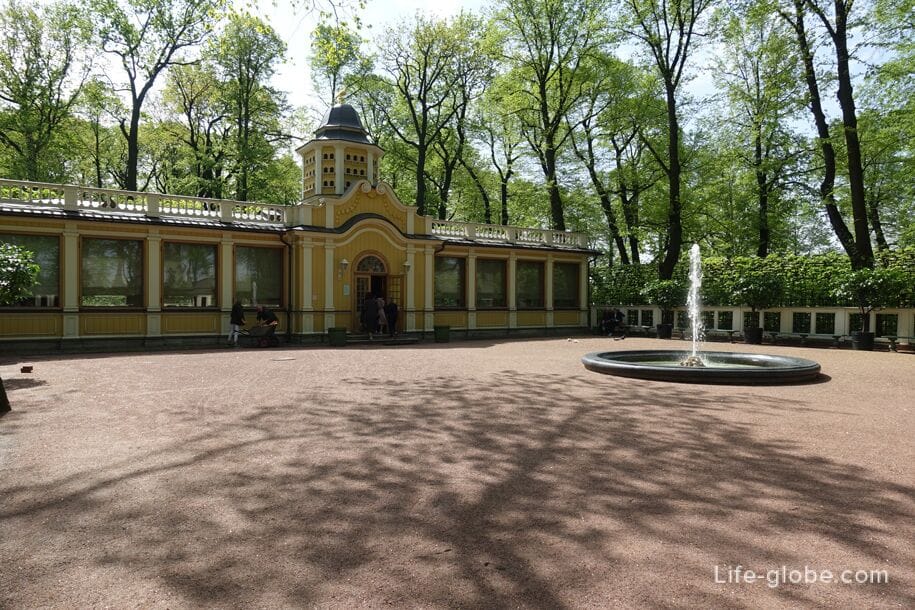

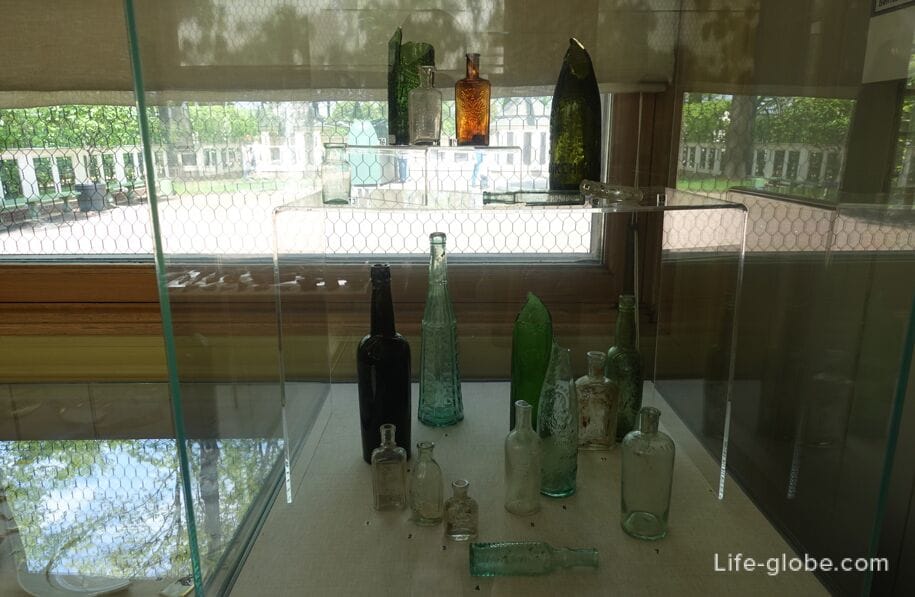

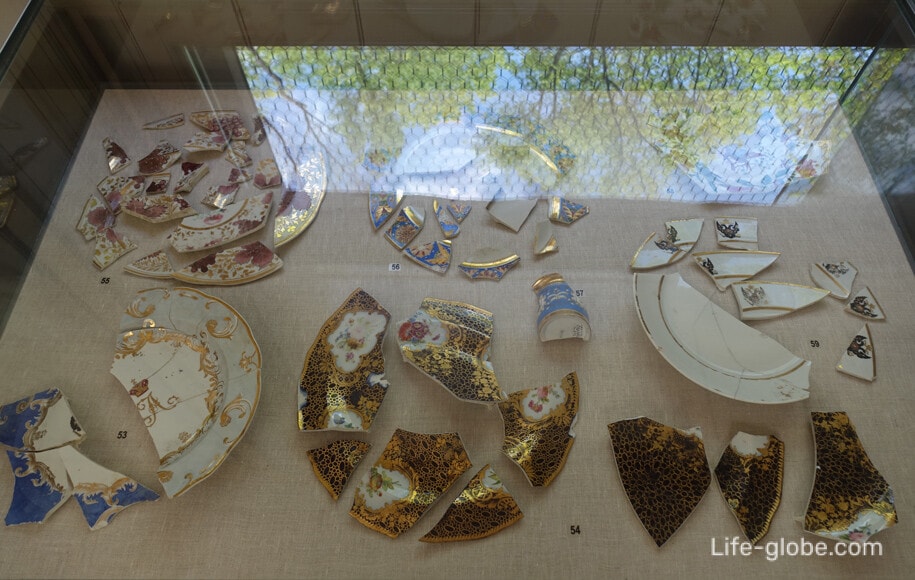
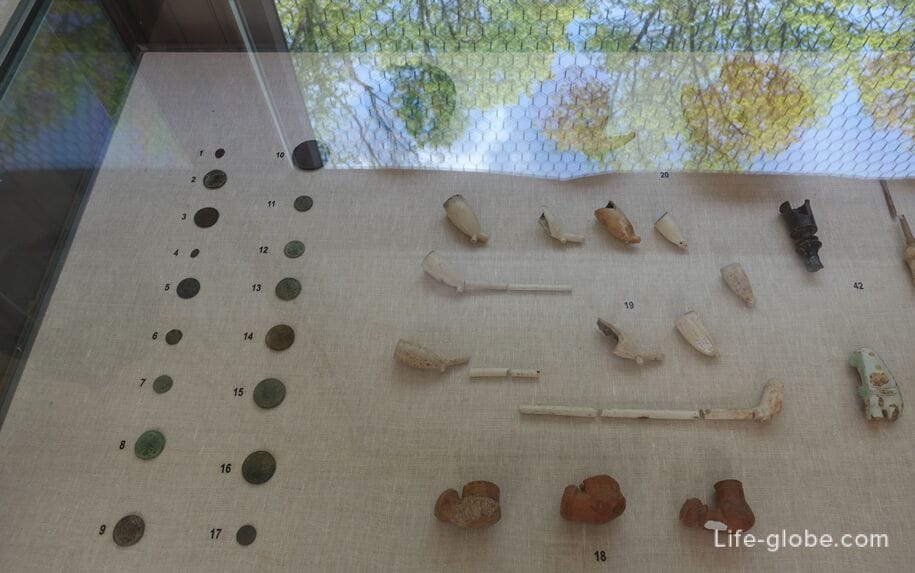
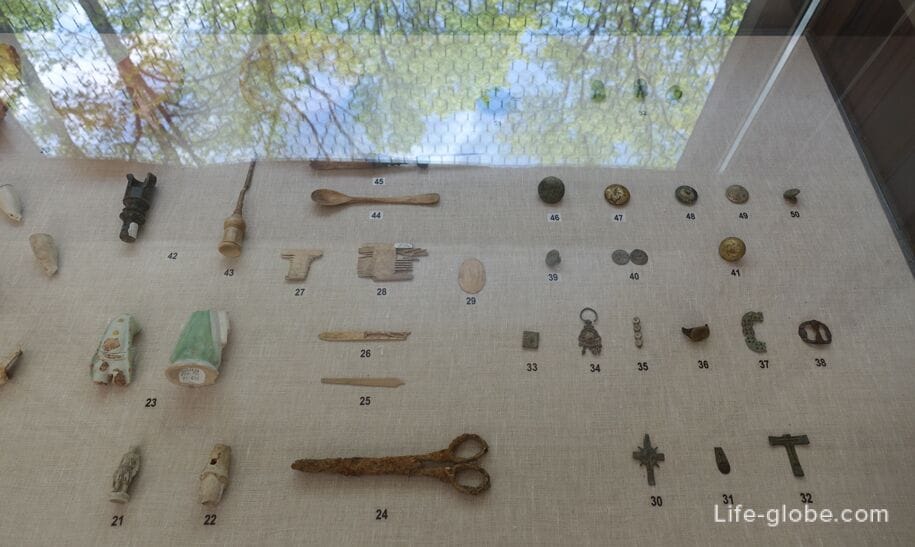


Berso
On the west side of the fountains and bosquets runs the alley-berso.
Berceau (from the French "berceau" - "cradle") is a vaulted alley and an element of a regular garden that appeared in Europe in the 17th century. In Russia of the 18th century, this technique, becoming popular, was called the "roundabout road".
The basis of the burso is a wooden lattice frame (trellis), to the elements of which the plants planted on both sides are attached by branches, thereby forming an extended shady alley.
The alley is formed by a small-leaved linden, specially formed in the form of arches.

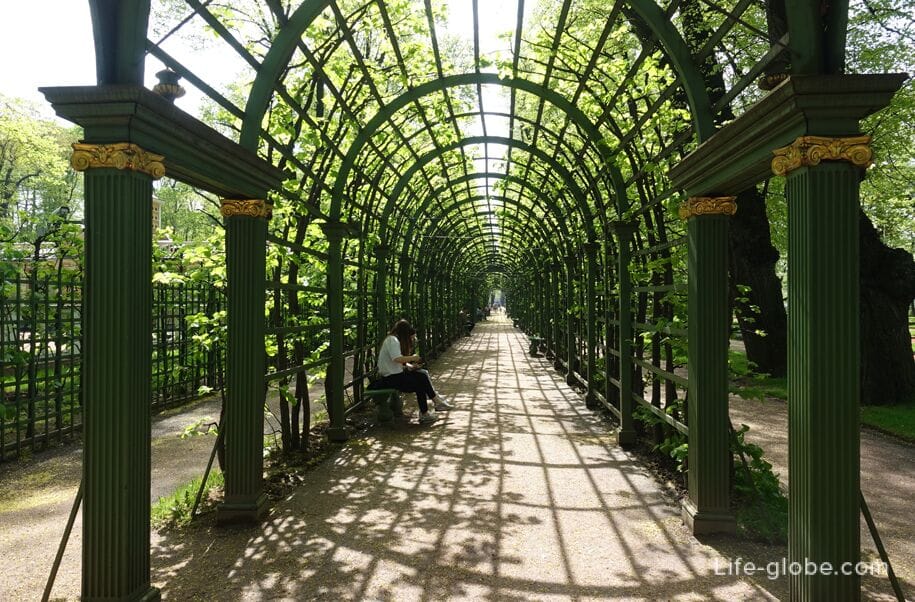

Front Porter and Crown Fountain
The northern western part of the park is decorated with a grand parterre with an exquisite Crown Fountain in the center.
Parterre-an open part of the garden, decorated with lawns, flower beds, fountains and statues.
The parterre of the Summer Garden was located in front of the windows of the palaces that stood on the banks of the Neva River (Catherine I and Anna Ioannovna).
The front porter is surrounded by an alley of old lime trees.
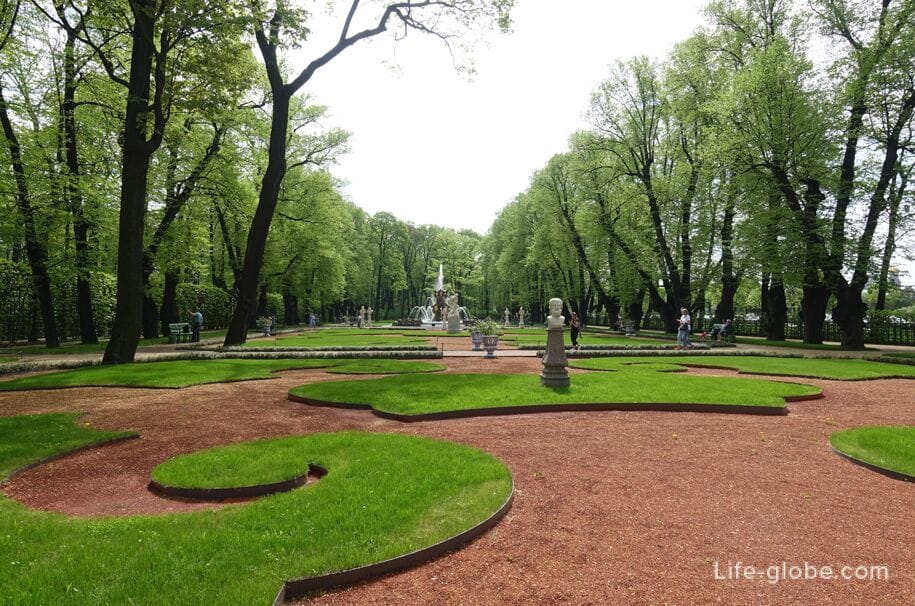
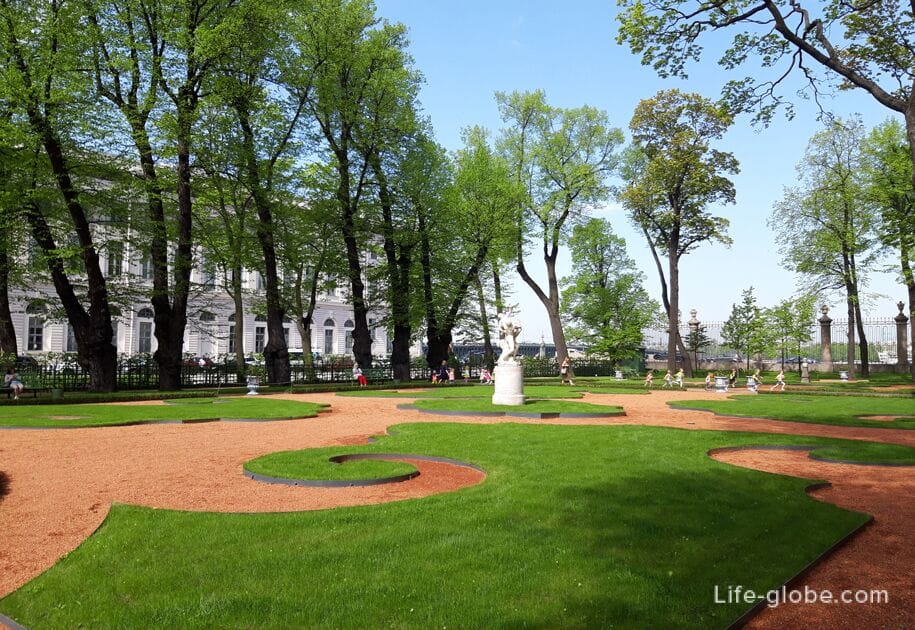

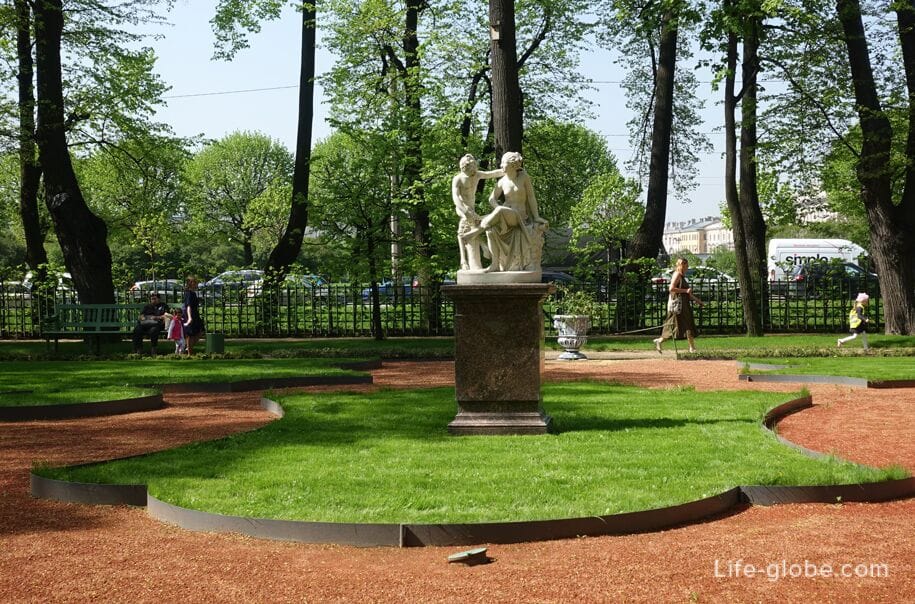
In the center of Porter is the most beautiful fountain of the Summer Garden - Crown fountain, surrounded by sculptures.
The Ball fountain was designed by architect Mikhail Zemtsov in 1725 and was originally located in front of the old main entrance to the Summer Garden-from the side of the "funny meadow" (now - the Field of Mars).
The name" Crown " fountain is derived from the shape of the jets forming a composition similar to the crown.
The fountain was damaged during the flood of 1777 and was filled in in 1789. Recreated on the basis of iconographic materials and archaeological research in 2010-2011.
The fountain is decorated with shells and gilded mascarons - a type of sculptural decoration in the shape of a human or animal head.
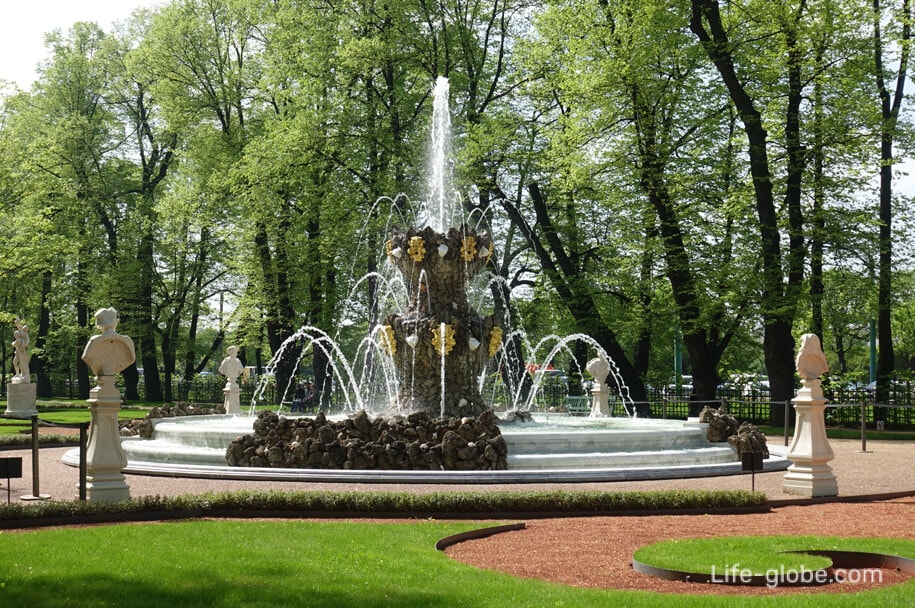
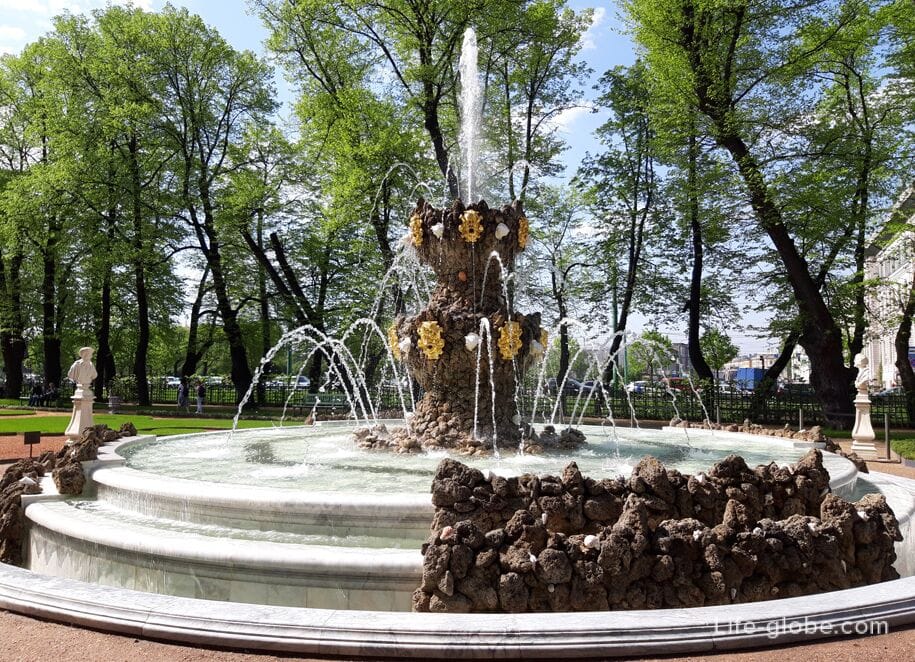
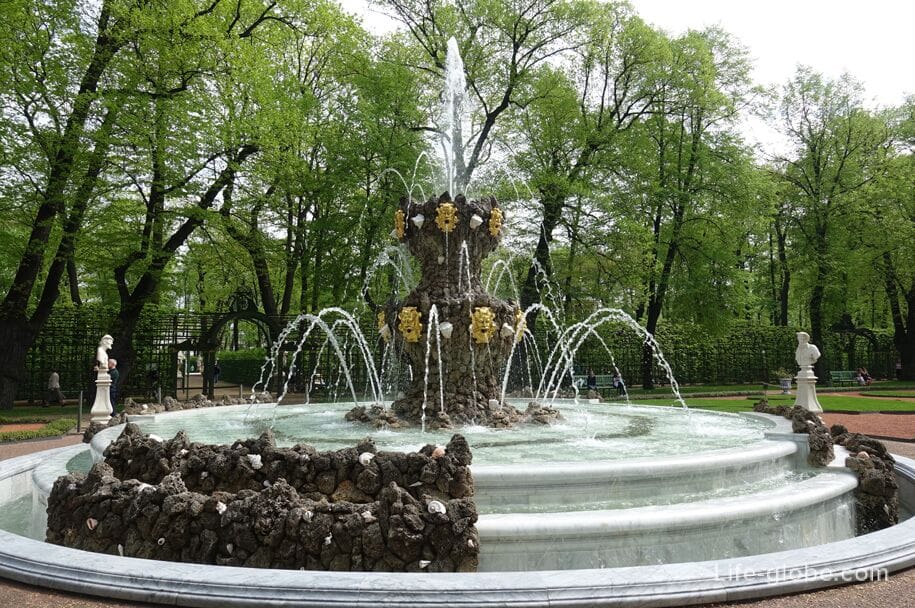
Video of the Crown Fountain in the Summer Garden
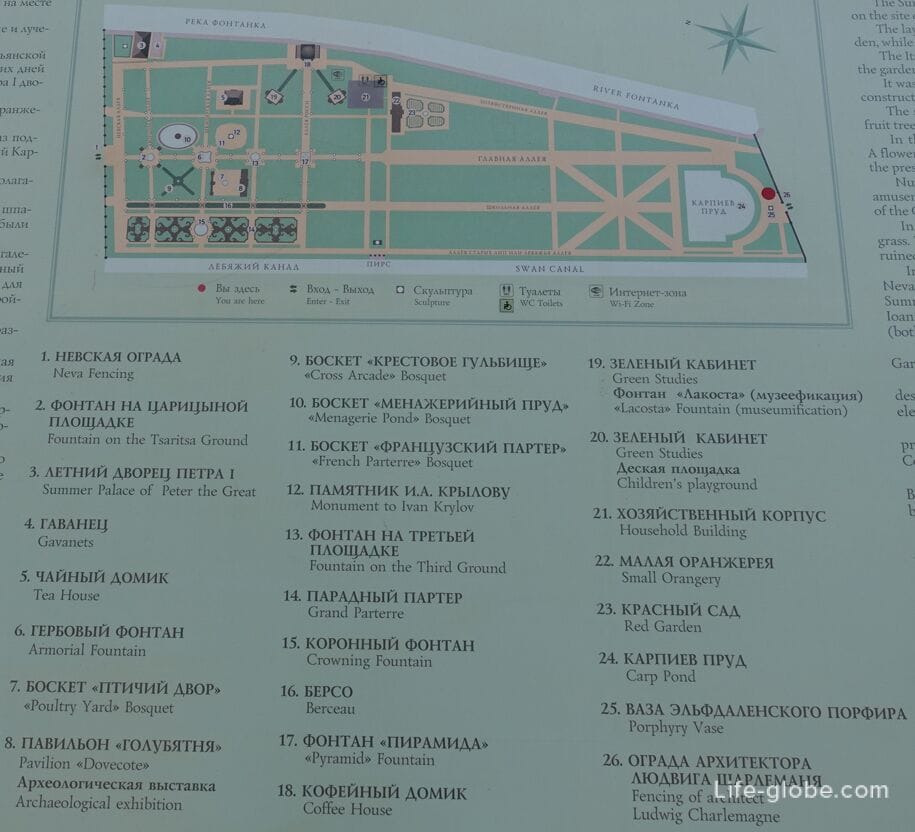
The Summer Garden is located in the heart of St. Petersburg, between the Swan Canal, the Fontanka River, the Palace Embankment (Neva River) and the Moika River embankment (Moika River).
Coordinates of the Summer Garden: 59°56'41.0"N 30°20'08.0"E (59.944722, 30.335556).
The nearest metrostations are Nevsky Prospekt, Gostiny Dvor, Admiralteiskaya and Chernyshevskaya.
Bus: №№ 46, 49, K-76 and K-212. Tram: № 3.
The entrance to the Summer Garden is free (free of charge).
You can enter the garden through two entrances: from the Palace Embankment and the Moika River embankment.
You can also visit the Summer Garden with one of the excursions
In the spring, somewhere in the month of April, the garden is closed for drying. Also, the garden may not work due to weather conditions and routine maintenance.
We recommend that you check the opening hours of the Summer Garden and its pavilions directly before visiting the official website.
Summer Garden website: summer-garden.
All accommodation facilities in St. Petersburg, including in the city center and more remote from it, can be viewed and booked here